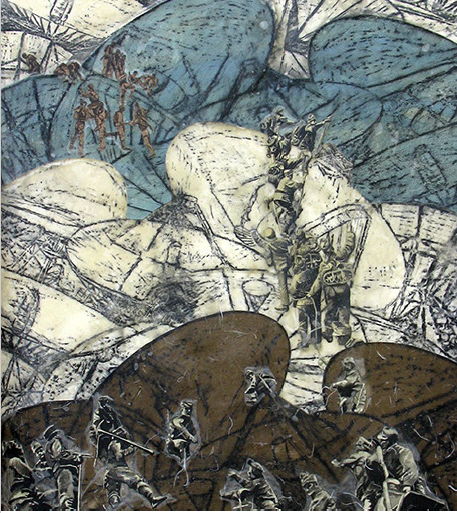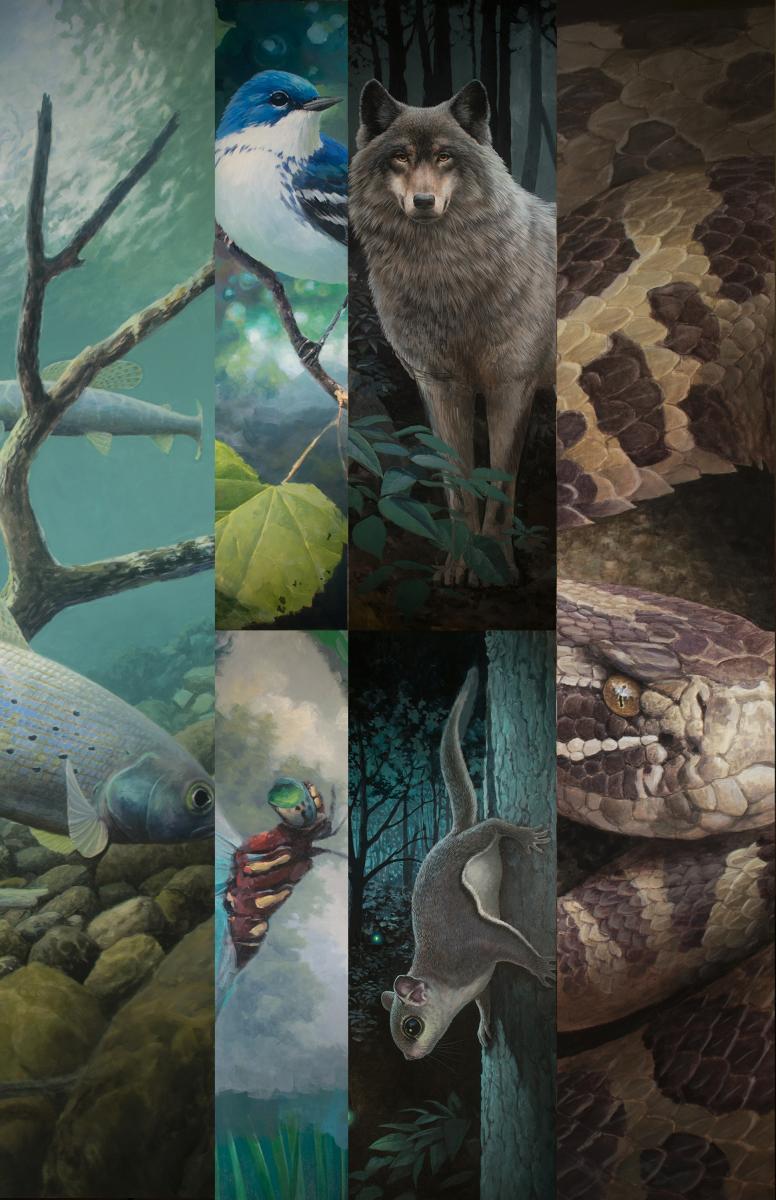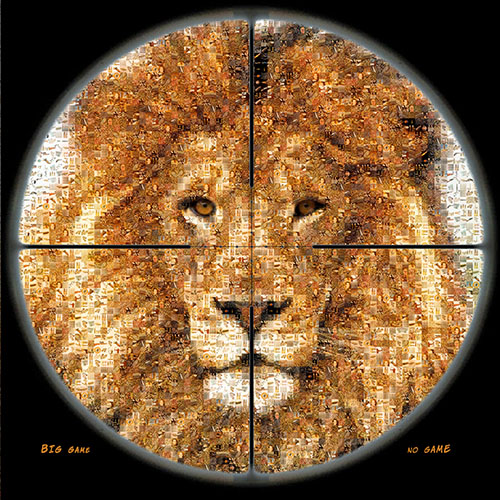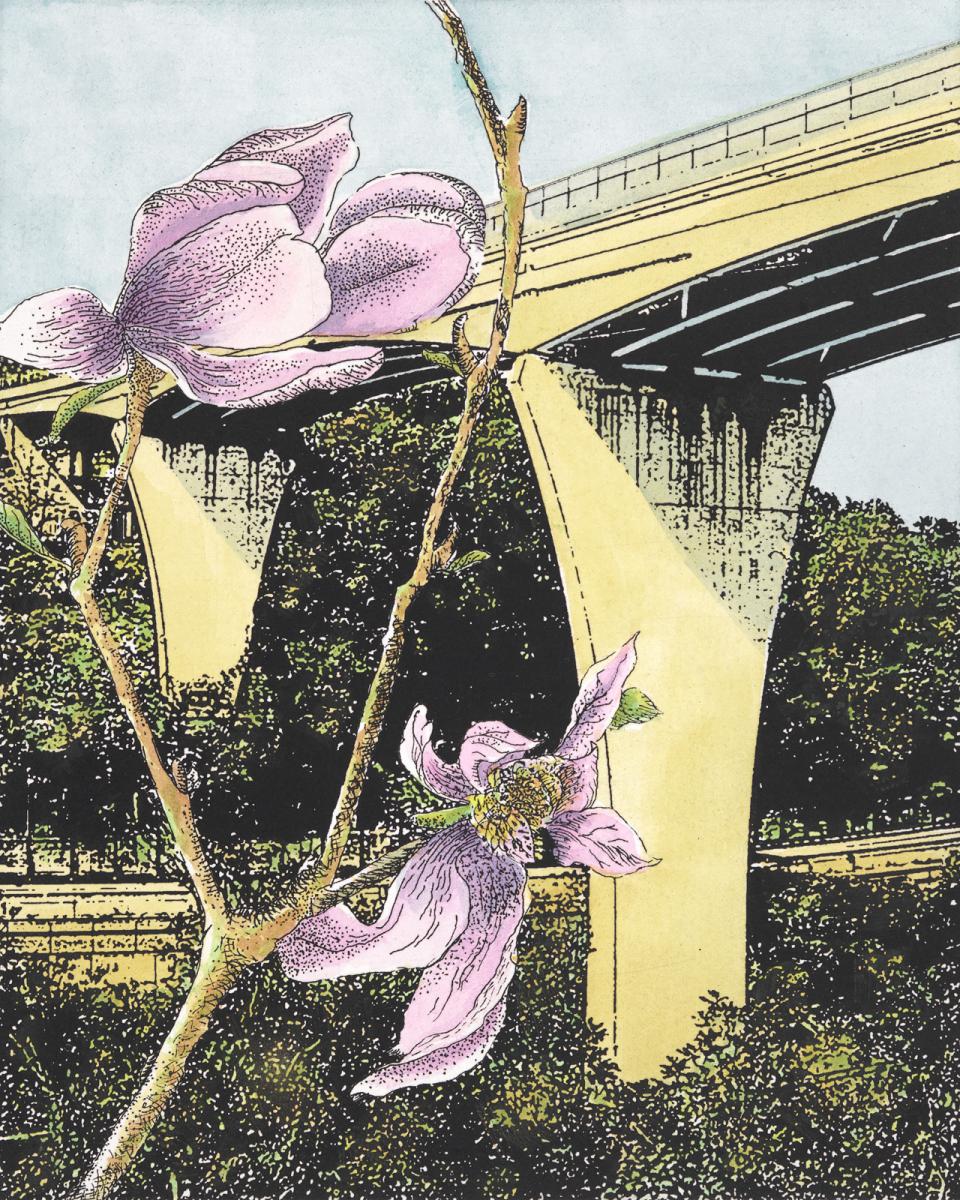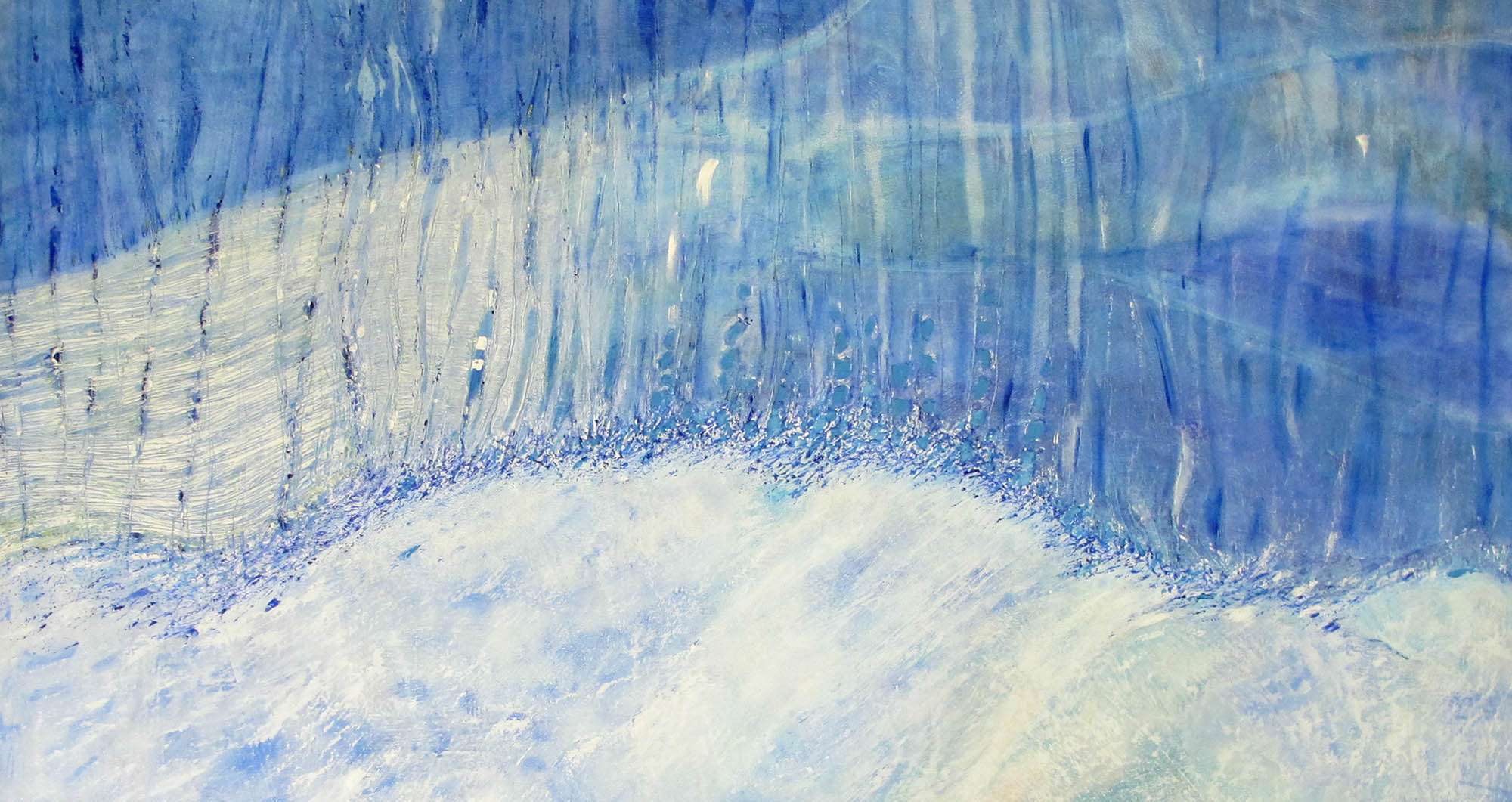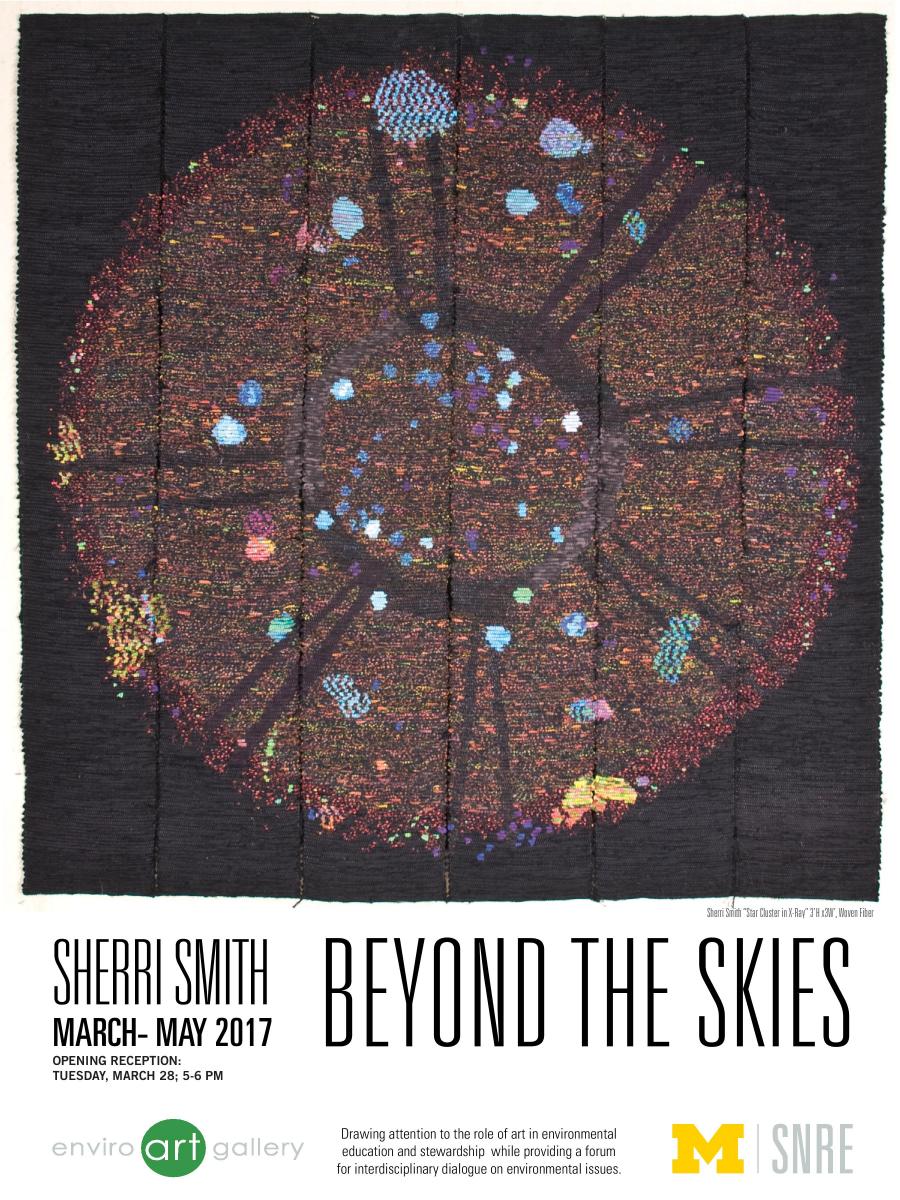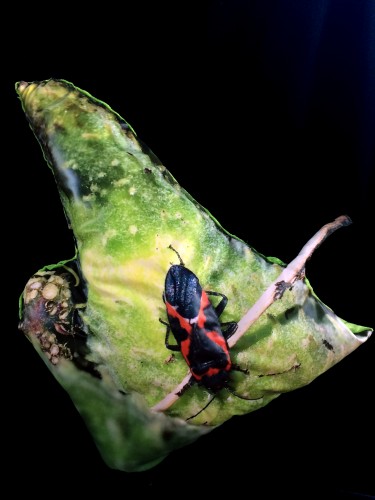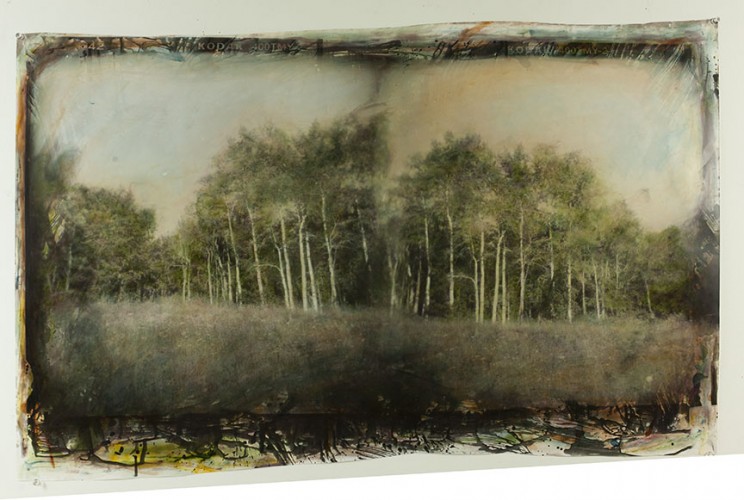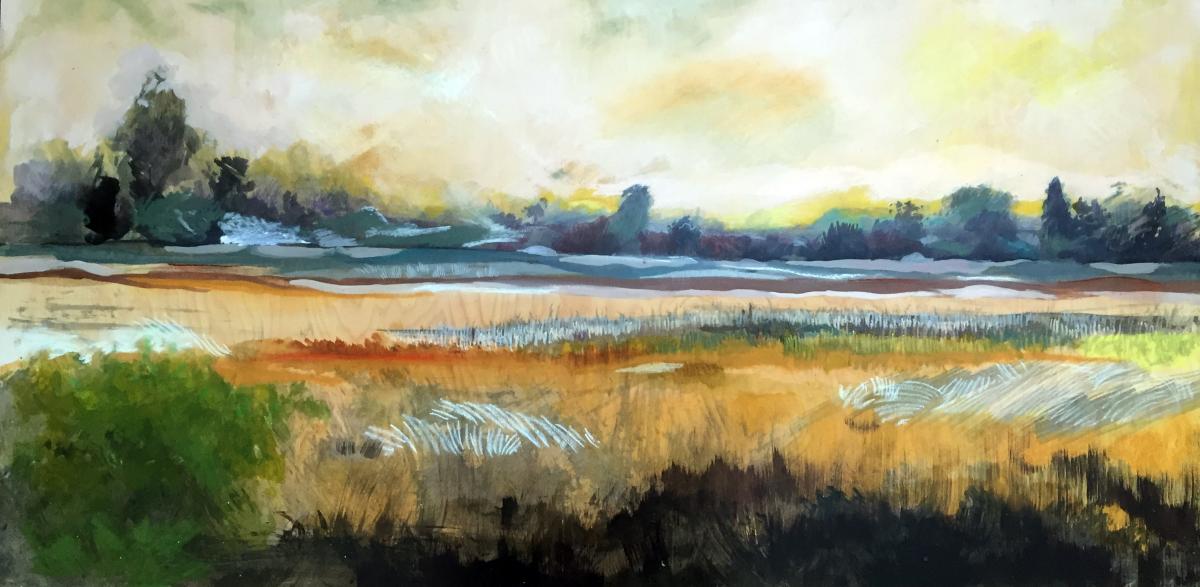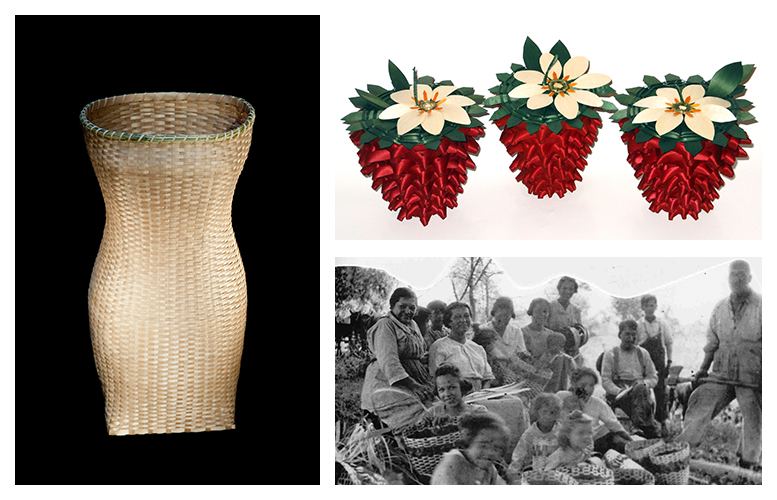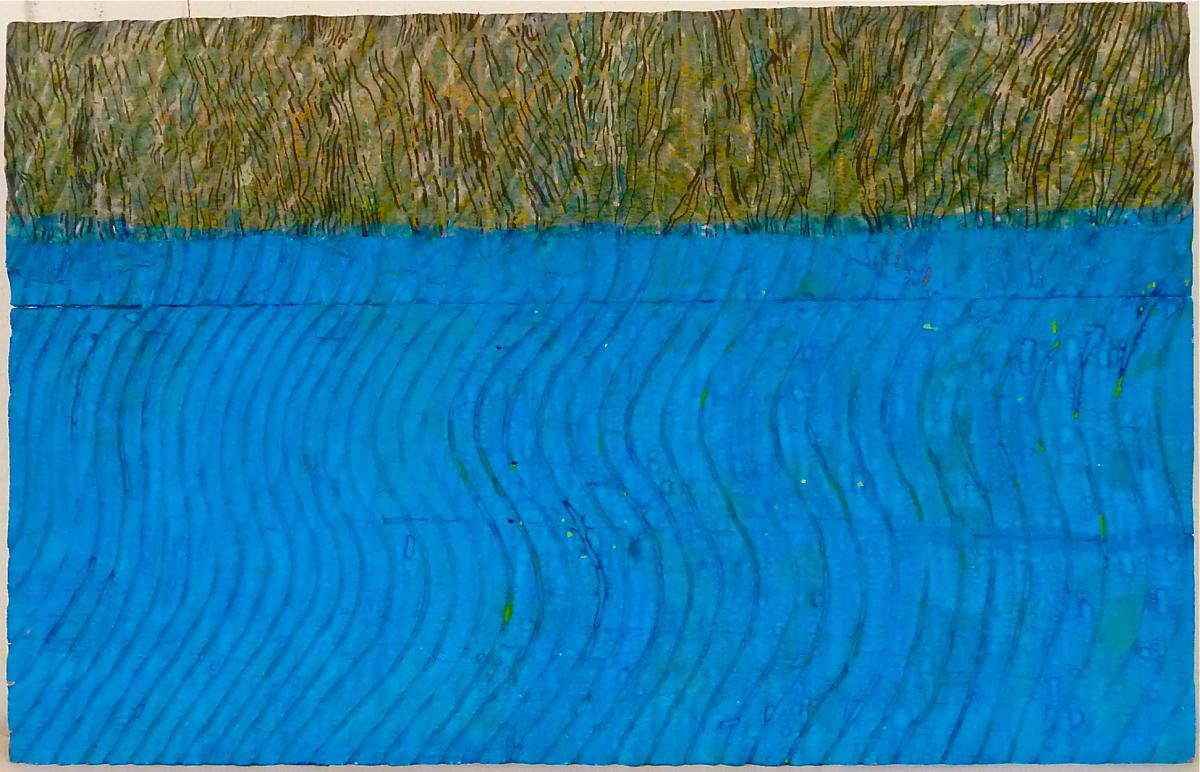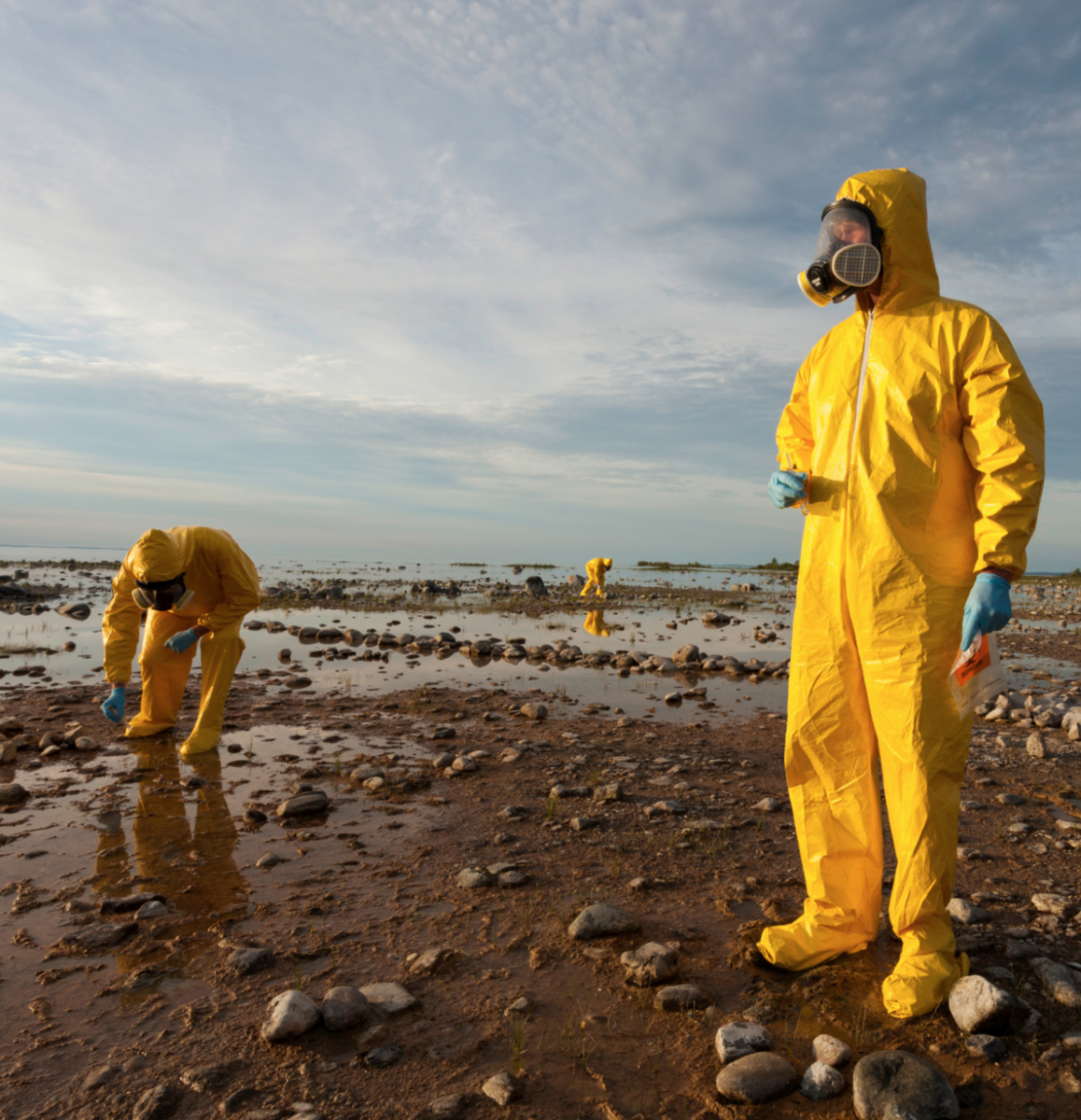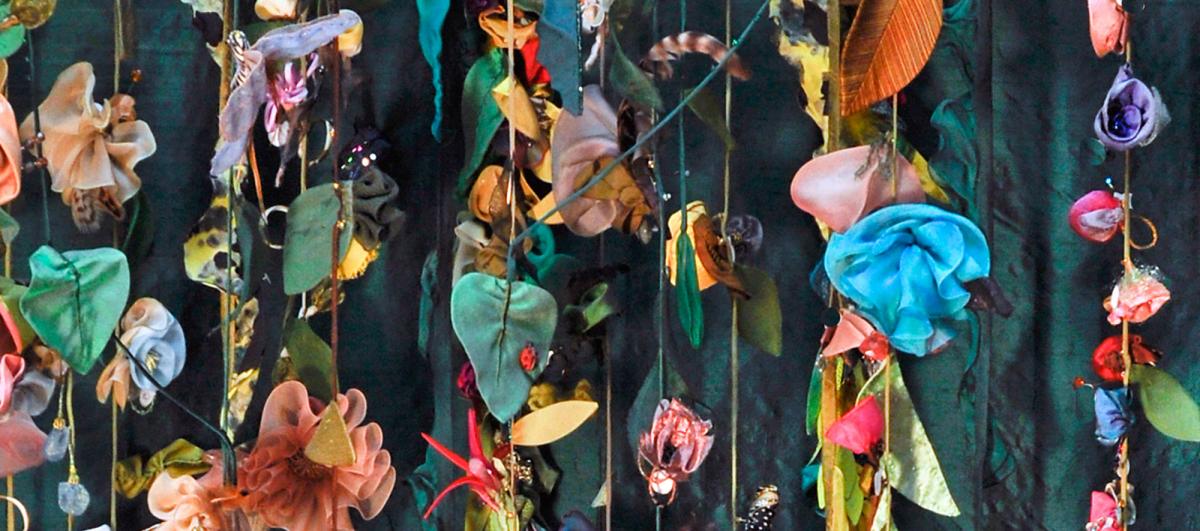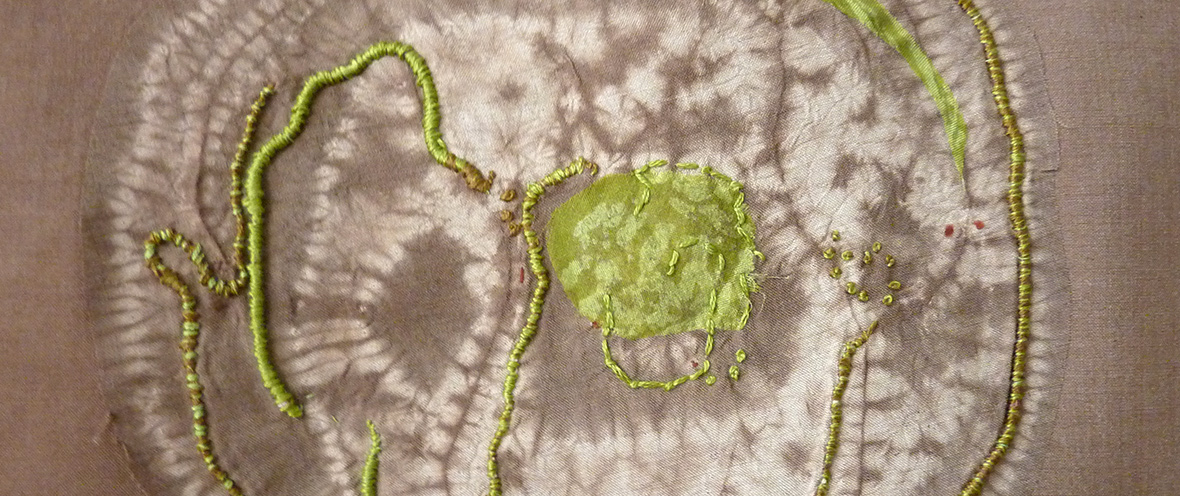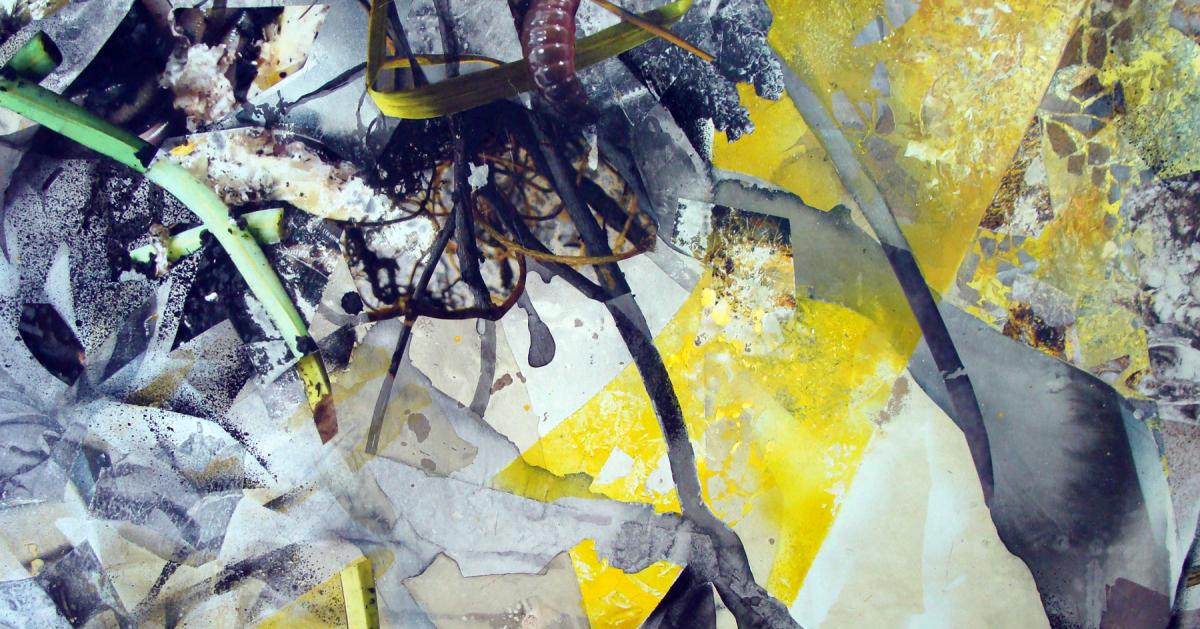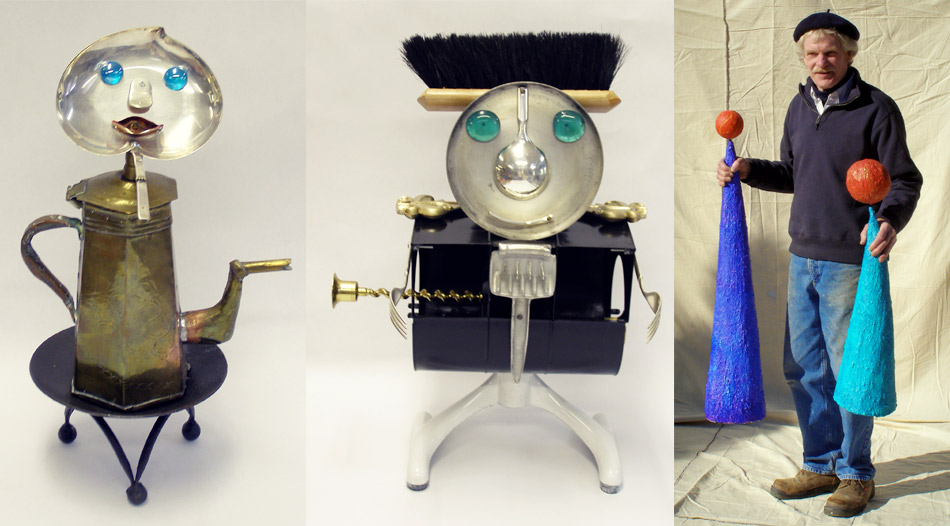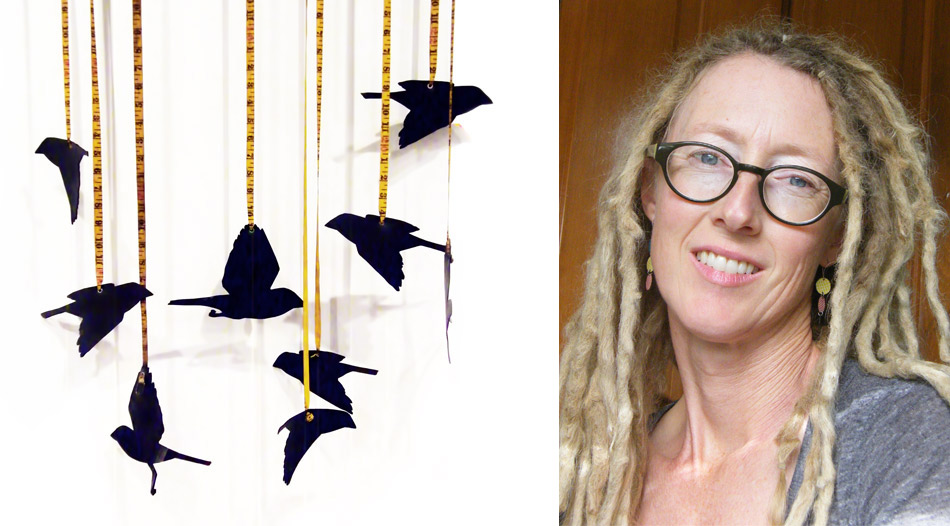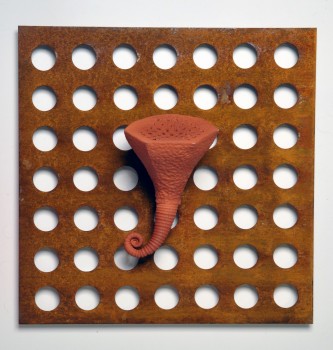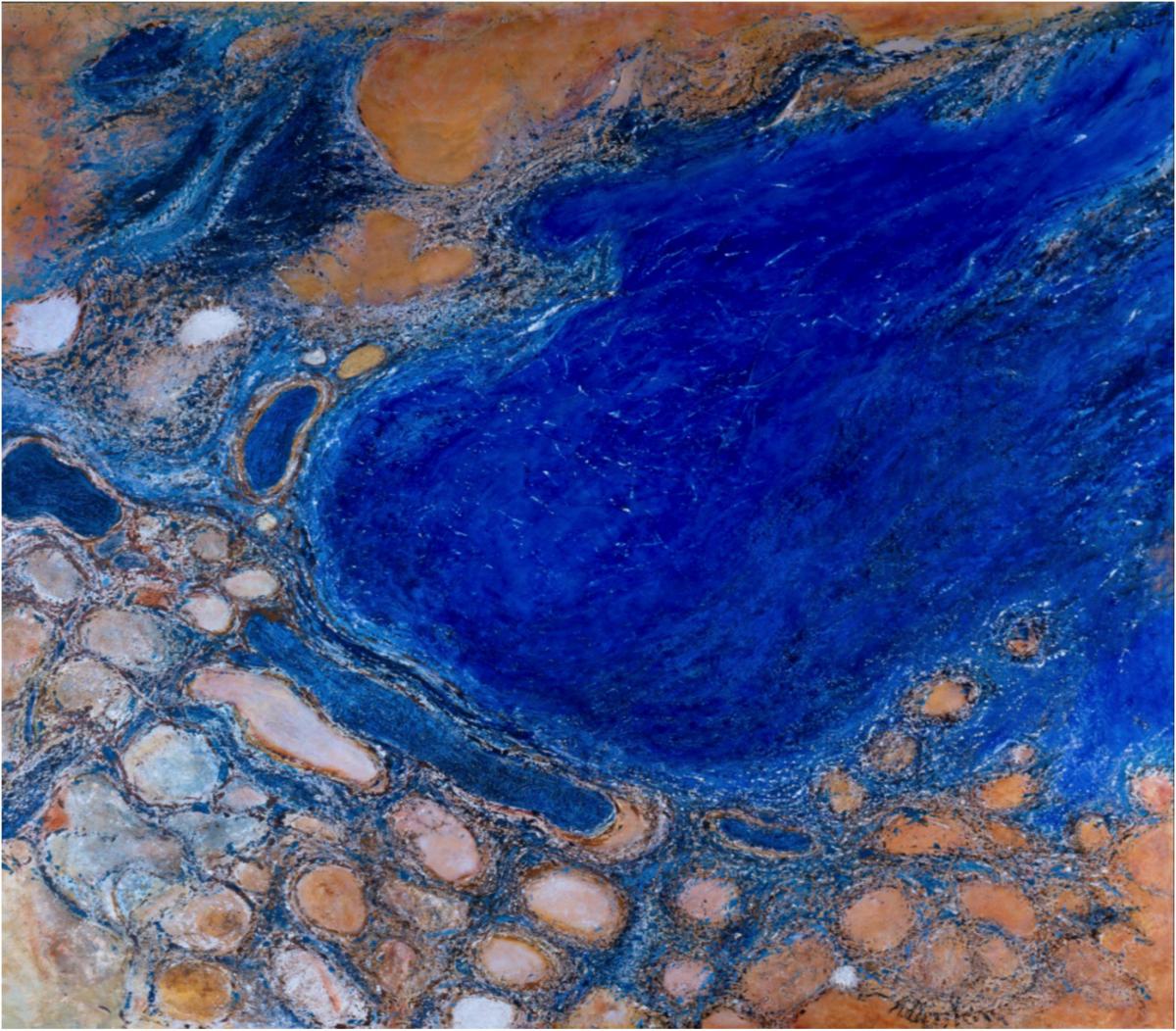
About the gallery
The Art & Environment Gallery is sponsored by the University of Michigan School for Environment and Sustainability (SEAS) and is located in the Ford Commons on the first floor of the Dana Building. Exhibits rotate regularly and are presented in five showcases. The gallery opened in February 2012 to underscore the influence of art in shaping our understanding of science and nature. It features local and national artists whose work speaks to how people interact and understand the environment.
Sara Adlerstein Gonzalez, SEAS Associate Research Scientist, is the gallery organizer and curator. Read more about her in eCurrent Magazine.
For more information about past exhibits featured in the gallery, see the list below.
Monarch Wings: Art Exhibit and Reception
About the Artists: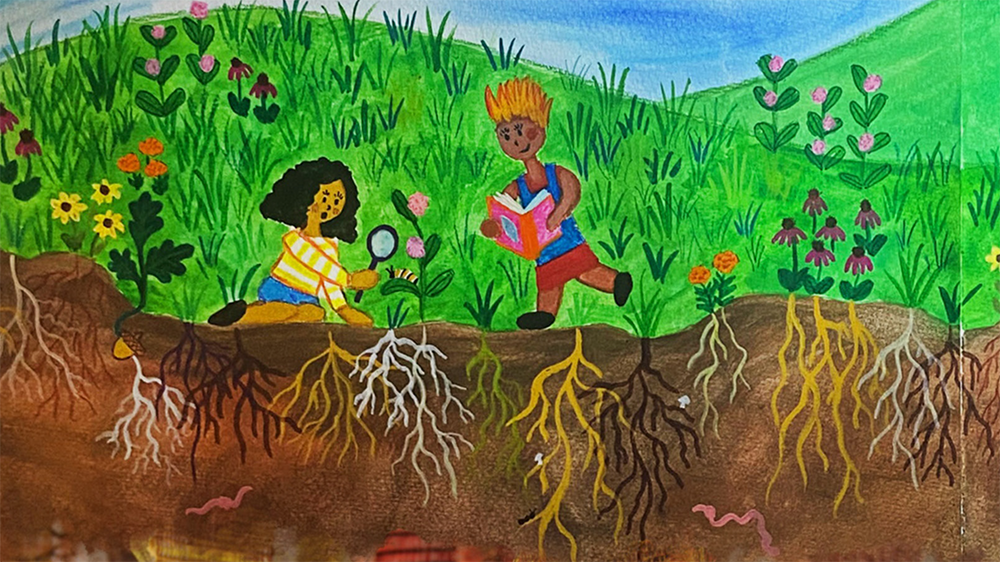
Boisali Biswas is a studio artist working in mixed-media fibers, born and brought up in India. She completed her BFA at Visva-Bharati University and MFA at Bowling Green State University. The essence of the profound experience throughout her educational journey has stayed with her and continues to influence her work, as well as living in this country and adapting to Western styles and inspirations for over three decades.
Esha Biswas is an artist and conservation ecologist pursuing a MS at the University of Michigan, School for Environment and Sustainability. She is passionate about the intersections of ecological restoration, environmental education and the arts. She currently works at Growing Hope as their Youth Programs Manager.
About the Work:
Monarch Wings is a collaborative exhibit and visual conversation between Boisali’s love for nature and Esha’s experience conducting prairie restoration and ecological educational work. This work in collaboration with the Freeman Environmental Education Center in Ann Arbor is a unique example of arts integration as a tool for environmental education. Monarchs were chosen for this exhibit because tell stories of cross-continental migration, transformation, and ecological interdependence, themes which unite both Boisali’s and Esha’s artistic journeys. Monarchs have been important symbols in mother and daughter artistic and ecological practices and a connection to the Anishinaabe land that they are guests on.
Thank You For Your Service: A Group Exhibit Confronting Environmental Crises
In this group exhibit, Thank You For Your Service: A Group Exhibit Confronting Environmental Crises, the selected artists address environmental issues including climate change and use their work to foster awareness and sustainable actions among the public.
About the Artists:
Sara Adlerstein
Sara is an aquatic ecologist, artist and curator. She holds a MS at the University of Concepcion Chile and MS and PhD from the University of Washington. She is a research faculty and Lecturer in the School for Environment & Sustainability where she advocates for a vision bridging arts and sciences. She is a member of the WSG Gallery and created and directs the Art & Environment Gallery.
“In my world, art and science belong together as naturally as water and air. I view art as a vehicle that extends the reach of traditional ways of communicating environmental issues and influence change. I feel constrained in my role as ecologist. As an artist, I am free to express my dismay about how we are affecting the planet and advocate for common sense.”
Cathy Barry
Cathy is an artist and art instructor. She holds a BFA from the University of Michigan and a MFA from Eastern Michigan University. She is a Lecturer at the University of Michigan, Stamps School of Art and Design, Program in the Environment, and the Biological Station.
“My most recent interests lie in art making materials and their impact on the environment. I am focusing on foraged plant material and the process of making pigments and three-dimensional objects with them. The intention to approach our endeavors with more integrity and understanding that we live in an interconnected ecosystem where each part effects the other is paramount to my practice and teaching.”
Todd Gilens
Todd Gilens is a San Francisco Bay Area – based writer and visual artist. His current projects link stream science, urban experience, and regional ecology. He holds a master’s degree in landscape architecture from Harvard University, leads workshops, and designs private gardens. Visit his website at www.toddgilens.com.
“In artwork , I look for something I haven’t yet seen, but once appearing, feels as if it has always existed. Materials and how they are worked, express traditions and moods, images associate to other images, and boundaries can be converted to bridges. Whether a garden, public art installation, or sketch, each part of experience reflects a whole, a whole that is everywhere, with an artwork temporarily at its center.”
Ann Rosenthal
Ann explores intersections of nature and culture through environmental issues. Her work comprises installation, painting , printmaking , and community projects. She was an artist in residency at HJ Andrews Experimental Forest, Oregon; co-curator for “Crafting Conversations: A Call and Response to Our Changing Climate,” Pittsburgh; and co-editor for Ecoart in Action: Activities, Case Studies, and Provocations for Classrooms and Communities (2022). She received the 2020 PennFuture “Woman of Environmental Art” award.
“At the core of my work is an unwavering desire to “repair the world” (Tikkun Olam in the Jewish tradition), and specifically to repair our relationship to non-human nature. Art can be one means to disrupt our anthropocentric mindset that splits nature and culture, to remind us of the community of life from which we have been estranged.”
Leslie Sobel
Leslie is the daughter of two scientists. She holds a BFA from University of Michigan School of Art and a MFA from the University of Hartford. She works in mixed media incorporating photography, scientific data, painting , printmaking , sculpture and performance and curates exhibitions focused on climate and social justice.
“My work focuses on climate and water. I work with scientists, taking and incorporating data with mixed media to make emotionally resonant work that helps people connect to intellectually complicated ideas about the environment. I prefer to connect with a place physically so that my experience of ground truth can feed my understanding and my emotional relationship with it as well as the data my scientific partners provide.”
Terra: The Land Resists I
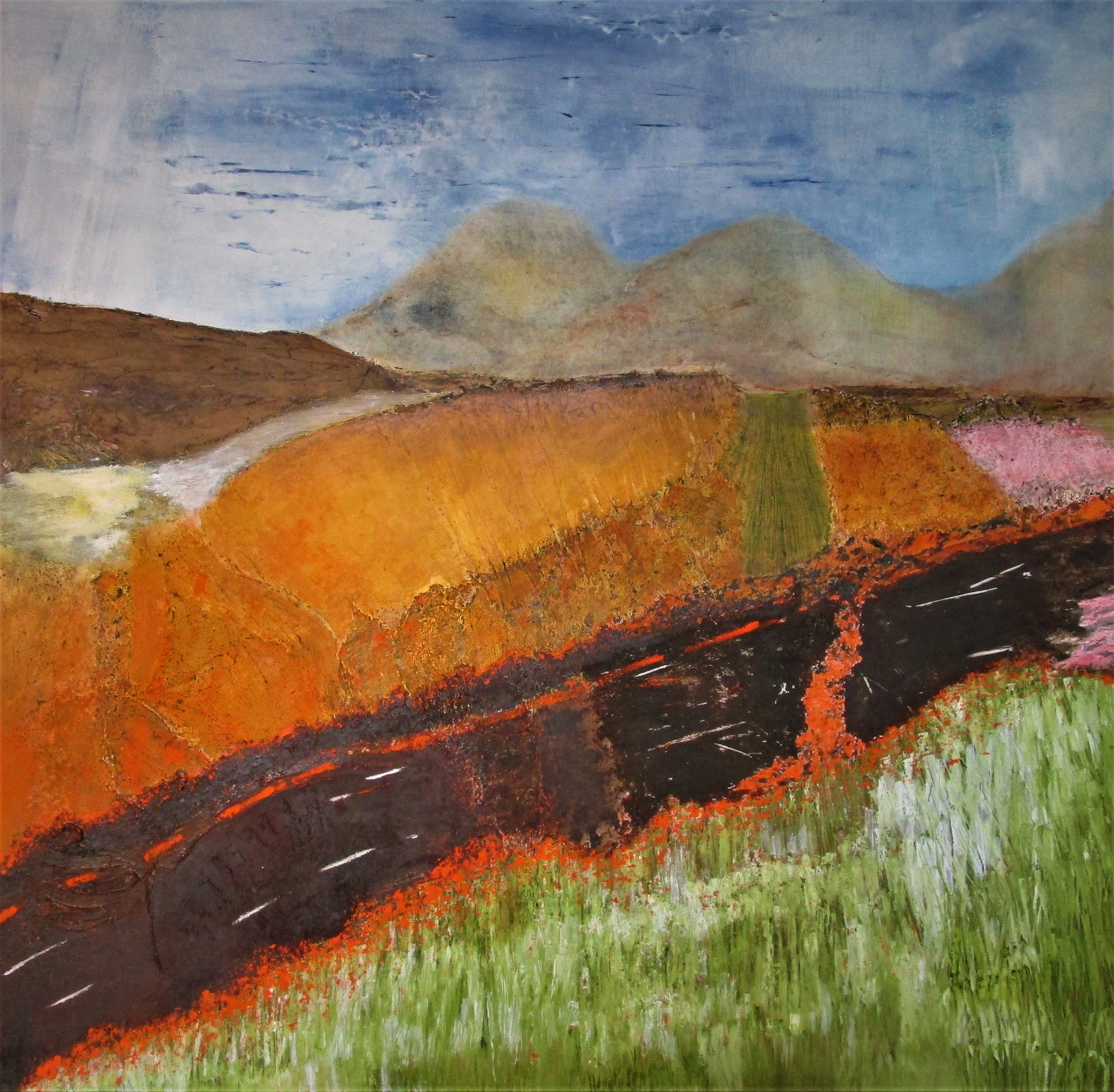 About the Artist:
About the Artist:
Adlerstein is an applied aquatic ecologist, visual artist and curator. She obtained a MS at the University of Concepcion Chile and a MS and PhD at the University of Washington. She has been painting for as long as she has been a scientist. Her art is published in books and magazines, shown in galleries and museums in Chile, Europe, Canada and the U.S. and are part of public and private collections. She is currently member of the Ann Arbor WSG Gallery and an Associate Research Scientist and Lecturer in the School for Environment & Sustainability (SEAS). She advocates for a vision bridging arts and sciences. Consistent with that vision she has taught environmental humanities courses in SEAS, the Program in the Environment, Residential College, and School of Art AND Design. She has organized and participated in events to immerse the arts within fabric of the university. She created and runs the Art & Environment Gallery in SEAS. Adlerstein joined U-M in 2001 with her husband Edgar Meyhofer, a Professor in Mechanical Engineering.
About the Work:
I am a scientist and a visual artist, or the other way around…
In my world, art and science belong together as naturally as water and air. Observation, experimentation, improvisation, searching for patterns all come together within the creative process. As such, I have developed novel techniques and my research influences the subject of my paintings. The process is informative, nurturing and magical. I view art as a vehicle that extends the reach of traditional ways of communicating environmental issues and influence change. I feel constrained in my role as ecologist. As scientists, we are trained not to advocate for the environment. We can only investigate cause and effects of stressors, make predictions and document what we learn. As artist, I am free to express my dismay about how we are affecting the planet and advocate for common sense. Thus, my art is often environmentally based and images are built on my experience as scientist and my artist sensibility to communicate concerns, dreams, and emotions all emerging from a deep and relentless love for life.
This exhibit is part of the Arts Initiative - Arts & Resistance Theme Semester. You will find images born out of concerns about environmental crises. These represent threatened landscapes and call for change. They developed poetically while feeling my own fragility. They remind us that we are part of nature and we cannot longer deny that living unsustainably we alter our planet in negative ways. My dream is that my work will have an impact in moving human behavior in the right direction.
Erin Hoffman
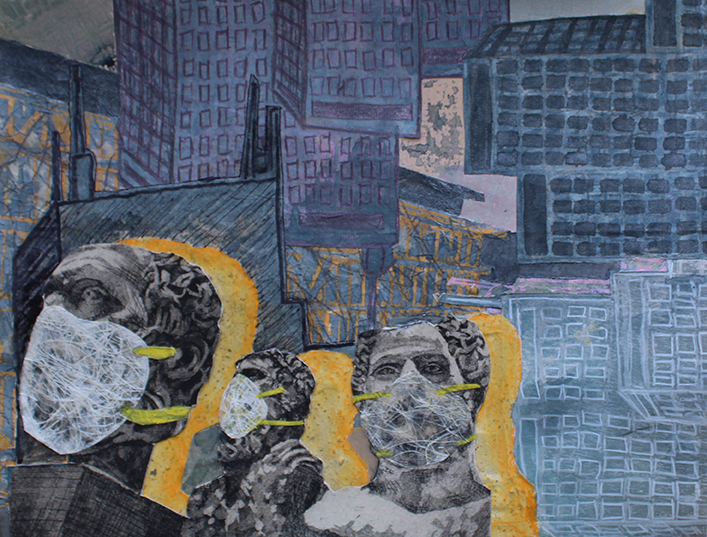
About the Artist:
Erin Hoffman is a full-time tenured art instructor at Muskegon Community College. She received her BFA from the University of Northern Iowa and MFA from University of Georgia and both degrees are in printmaking. Erin recently completed artwork at two artist residencies, one in Skopelos, Greece at the Skopelos Foundation of the Arts and the other at Corvidae Press in Port Townsend, Washington. Her work mixes different printmaking techniques with painted and drawn components. She uses historical and politically themed imagery to examine contemporary aspects of American society.
About the work:
"I feel that one experiences and draws conclusions about the world through the assembly of mismatched ideas and sensorial memories. Sometimes the associations of these ideas are seemingly random and other times there are lines that can be drawn between them that may lead to overarching truths or conclusions. Remnants are the remains of something. This ‘stuff’ carries along with it both the essence of what it once was and the potential for what it could become. When combined with other ‘stuff’ an entirely new thing is formed. In printmaking, in addition to the prints themselves you're left with the matrices you used to create the work. Although there is always the possibility for reprinting an edition, in most cases the remaining woodblock or litho plate never has another purpose. The creation process for the remnant series quite literally involves reusing and recontextualizing portions of work that I have made in the past."
-Erin Hoffman, Artist
Natural Abstractions
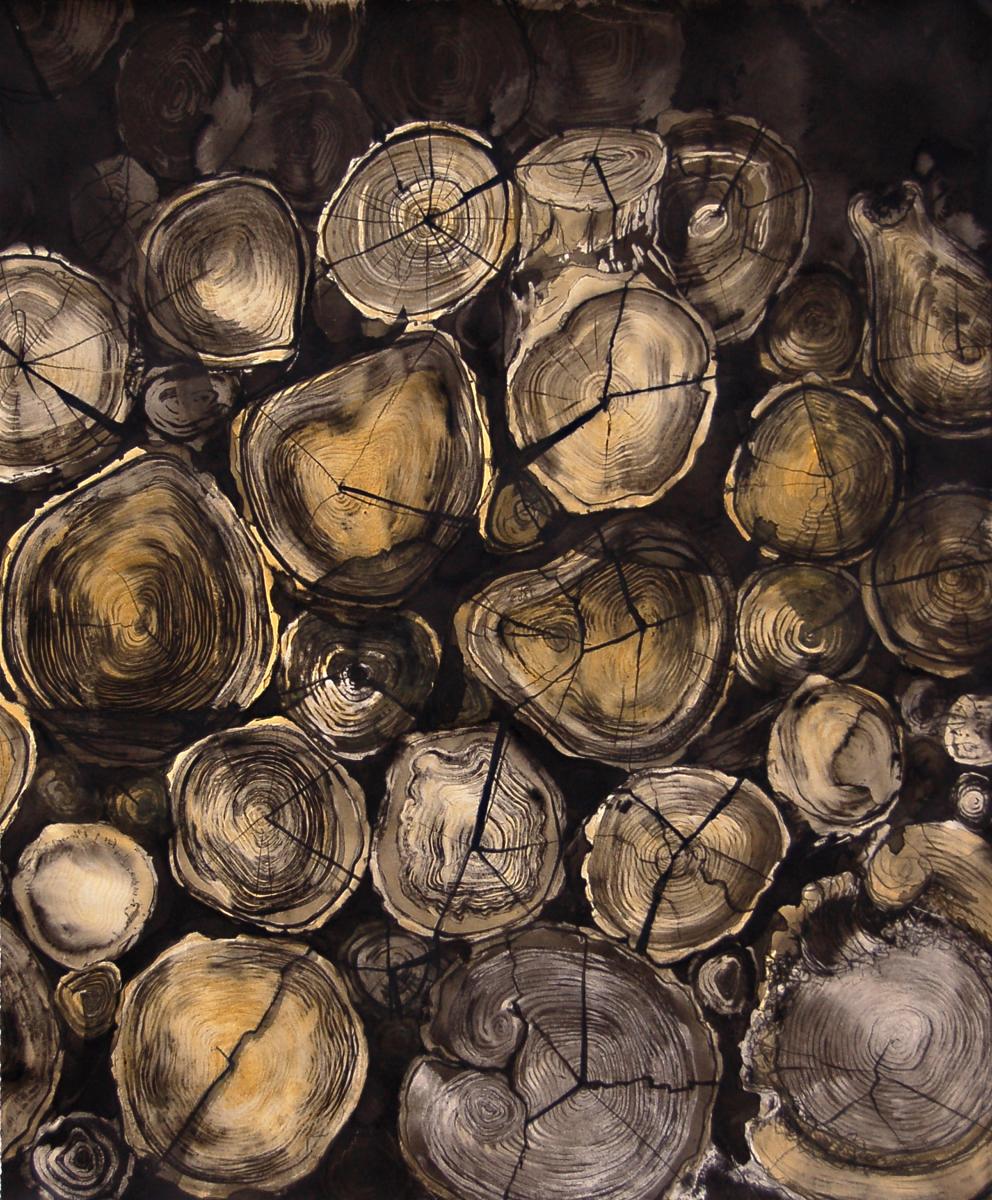
About the Artist:
Helen Gotlib is a graduate of the School Of Art And Design at the University Of Michigan. A life time commitment to art has led to a career as a full time fine artist. Over many years of training, including studies at the Kyoto Seika University, she has developed a detail oriented style incorporating drawing, printmaking and mixed media processes. Much of Helen’s work focuses on life cycles of flora. She creates images of unexpected beauty and emotional power, particularly by focusing her attention on dried, dead flowers. Her work is exhibited across the country. More information about her work can be found at www.helengotlib.com. Helen was born and raised in Ann Arbor, Michigan. She lives in the woods of western Washtenaw County with her partner local artist Dylan Strzynski.
About the work:
"Natural Abstractions is a collection of drawings. The inspiration for the work and corner stone of my artistic practice is the subtle expressive beauty of nature’s life cycles. Recently I became interested in the way exotic visual associations can be conjured from common objects. The abstract possibilities of a head of cabbage and an ordinary stack of logs are of particular interest to me. Direct and magnified representation, through its deliberateness functions as a system for abstraction. Increasing the scale and size of the maze like interior of the cabbage or emphasizing the map like pattern within the logs obscures the connection to the original object. Viewers interpret the images in elaborate and mystifying ways. They see brains, shells, mushroom clouds and topographical maps for example instead of a cross section of cabbage or ordinary stack of firewood. The subjective nature of these images and the nature of the individual experience are fundamental to visual art."
-Helen Gotlib, Artist
The Remnants of Progress
About the Artist:
Erin Hoffman is a full-time tenured art instructor at Muskegon Community College. She received her BFA from the University of Northern Iowa and MFA from University of Georgia and both degrees are in printmaking. Erin recently completed artwork at two artist residencies, one in Skopelos, Greece at the Skopelos Foundation of the Arts and the other at Corvidae Press in Port Townsend, Washington. Her work mixes different printmaking techniques with painted and drawn components. She uses historical and politically themed imagery to examine contemporary aspects of American society.
About the work:
"I feel that one experiences and draws conclusions about the world through the assembly of mismatched ideas and sensorial memories. Sometimes the associations of these ideas are seemingly random and other times there are lines that can be drawn between them that may lead to overarching truths or conclusions. Remnants are the remains of something. This ‘stuff’ carries along with it both the essence of what it once was and the potential for what it could become. When combined with other ‘stuff’ an entirely new thing is formed. In printmaking, in addition to the prints themselves you're left with the matrices you used to create the work. Although there is always the possibility for reprinting an edition, in most cases the remaining woodblock or litho plate never has another purpose. The creation process for the remnant series quite literally involves reusing and recontextualizing portions of work that I have made in the past."
-Erin Hoffman, Artist
About the gallery
This gallery draws attention to the intersecting values, both artistically and scientifically, of art and the environment. Because of the way the SEAS curriculum embraces interdisciplinary fields, it is a natural place to host this gallery. We are bringing art to our school to strengthen our sense of community and facilitate dialogue among students, faculty and staff in the spirit of green-building philosophy.
- Sara Adlerstein Gonzalez, SEAS Associate Research Scientist and gallery organizer and curator. Read more about Sara in this article from eCurrent Magazine here.
The Art & Environment Gallery is sponsored by SEAS and located on the first floor of the Dana Building in the Ford Commons. Exhibits rotate regularly and are presented in five showcases.The gallery opened in February 2012 to underscore the influence of art in shaping our understanding of science and nature. It features local and national artists whose work speaks to how people interact and understand the environment.
Going, Going, Gone.
About the Artist:
John’s biography is not the typical artist’s story: he blundered through his first twenty-some years expecting to become a biologist - not an artist. After making it all the way through a MS in marine ecology, it finally got through his thick skull that he preferred drawing and painting animals to researching them. The obvious solution, at least in his mind, was to cram a bunch of drawings into a portfolio and start schlepping it about like a vacuum salesman. He targeted research departments of the University of Oregon and Oregon State and found he could corner startled professors and scientists in their offices long enough to listen to his spiel. After a year, enough money was coming in to pay for rent, health insurance, cat food and Peet’s coffee. He established a clientelle that included Weyerhaeuser Co., The American Fisheries Society, and St. Martin’s, MIT, Harcourt, and Mountain Press and others. This provided stability to John’s chaotic life and things were looking up. Then, in 1996, an advertisement for a scientific illustration position at the University of Michigan’s Museum of Zoology (UMMZ) was posted. John applied, assuming there was no chance he would be qualified, and was shocked when UMMZ director, Dr. Richard Alexander, invited him to an interview. All went well until, at Good Time Charley’s, John spilled barbecue sauce and other assorted condiments all over his shirt. In spite of this, he was hired. Since then, John has illustrated hundreds of research papers and other things at UM. In his spare time he paints wildlife art, teaches a concentrated biological illustration summer course at the University of Oregon, illustrates children’s books, and saws away on an old violin to the annoyance of his two cats. He lives in Ann Arbor with his wife, Anne, and two sons, Nicholas and Ian.
About the work:
"Paintings in the Going, Going, Gone represent about one one-hundredth of the number of species that are of concern in Michigan. Over 700 organisms are currently categorized as “of special concern”, threatened, endangered or extinct. I considered several criteria in selecting the subjects for each painting. First I contacted biologists who advised me on what species might be of interest. Then I considered the story of each species and threats they face. And finally I had to base part of my decision on the practical matter of whether I could gather appropriate visual references. In each portrait I strived to show the beauty of each organism and what we will lose if it goes extinct or, as in the case of the arctic grayling, what we have already lost.
-John Megahan, Artist
Protest Art
About the Artist:
Tom Detwyler was born in 1938 in Jackson, Michigan. He earned a B.S. in Botany at the University of Michigan, and a PhD at Johns Hopkins University. He retired from academia after holding tenured professorships at the University of Michigan, Willamette University, and the University of Wisconsin-Stevens Point. When he joined the Geography Department at U of M, in 1966, the field “environmental science” did not yet exist and he soon began teaching a course on human modification of the earth. Dr. Detwyler is the author of Man’s Impact on Environment (1971, McGraw-Hill) and Urbanization and Environment: The Physical Geography of the City (1972, Duxbury Press). Many experiences during the 1970’s influenced his environmental philosophy. Among others, an M.I.T. course on system dynamics with authors of Limits to Growth; a year in Hawaii examining Oahu as energy system; creation of a popular course “Low Energy Living”; successful protest with the Black Action Movement of U of M’s Apartheid investments in South Africa; actions against war in Southeast Asia; planning with Peter van Dresser of an experiment in low-energy, high-amenity living in New Mexico; and participation in a U.S. delegation to the Soviet Union focused on urban environments. Detwyler’s art is an outgrowth of his career as environmental scientist, however he started experimenting with photography early in life. At the age of 12 he bought a used 35 mm Exakta II camera to photograph nature, and soon established a darkroom at home. At U of M he took a photography course from Professor Phil Davis, and at Indiana University he took courses in cinematography. Later, as a faculty member, Detwyler employed photography and other visual media throughout his 35 years of research and teaching. At U of M, he produced six videos of “Low Energy Living” experiments. In Wisconsin, he directed production of Our Environment videodisc with selection of 6,000 slides from photo collections, and produced ten topical CD-ROMs, each with color photos and explanatory captions (Optilearn, Stevens Point, Wisconsin). He has displayed his art in numerous photography juried exhibitions and obtained several awards. Since 2005 his photography has evolved into conceptual art addressing environmental and political challenges.
About the work:
"Primarily, my art is directed against forces of environmental destruction, especially protesting the anti-life consequences of corporate capitalism. Upon recognizing vast ranges of profound human impacts on environment, my paramount concern became, “What causes such human actions?” By the late 1970s I concluded that the basic cause of serious environmental problems is corporate capitalism. Capitalism’s overriding goal is to maximize short-term private financial profits. Capitalist blowback against environmental ethics and rules, remarkable since the 1980s, has substantiated my judgment of four decades. On the other hand, environmental and societal equilibrium—sustainability—necessitates minimizing long-term public environmental hazards, and respect for broad social welfare and qualities beyond financial measurement. This standard is usually at odds with capitalism’s gauge. Existing models for sustainability are, at best, only partially tested in real life. But it is clear that a survivable transition from unstable capitalism to sustainability requires nothing less than a political economic revolution. Short of this, the transition may be earth-shattering. Protest art, criticizes existing societal conditions and institutions. It is a kind of conceptual art, in which the concept involved in the work is more important than traditional aesthetic, technical, and material concerns. In the formal art world it emerged in the 1960s, as reaction against the tradition that formal qualities of a work such as line, shape and color are sufficient for its appreciation. Conceptual artists commonly appropriate work created by others for incorporation into new art. Art protesting environmental conditions appears to have increased recently, particularly beyond the formal art world. Editorial cartoons and political posters are significant examples. The best protest art uses content, as well as design, to startle the viewer, to jar thinking—and, ideally, to provoke action. In my environmental protest art the fundamental elements are photographs. Some works are collections of many images where I combine pieces into a montage. I may appropriate others’ images, such as parts of advertisements. A mosaic provides special artistic opportunity: the large image seen at a distance may contrast with the close-up view of numerous small images (tiles); the two types of image may appear to be paradoxical, contradictory or ironic, thus making a statement. I incorporate text in some works; the text may be minor, extensive and explanatory or may even constitute most of the work. The ultimate challenge—especially great with complex concepts—is to create an overall image that will make an idea clear. In this show I tackle climate change, toxic waste, poaching, and globalization. Some works question the behavior of noted persons."
-Tom Detwyler, Artist
Biophilia: From the Studio to the Community
About the Artist:
Ann Rosenthal received her MFA from Carnegie Mellon University in 1999 and brings to communities over 30 years’ experience as an artist, educator, and writer. Her work examines the intersections of nature and culture through timely environmental issues. She teaches mixed media, collage, visual journaling, and printmaking workshops in her studio, and art history and environmental art through Osher Lifelong Learning Institute at the University of Pittsburgh. Rosenthal’s art has been shown in Pittsburgh at the Andy Warhol Museum, the Mattress Factory, SPACE, and several universities and colleges. Her work has been featured in exhibitions across the U.S. and internationally. Her essays on eco/community art have been published in journals and anthologies, including “Redefining Beauty in the Context of Sustainability” in Regenerative Infrastructures, (New York: Prestel). She initiated and currently directs LUNA (Learning Urban Nature through Art), a community-based ecoliteracy and art program.
About the work:
"Over three decades, I have sought answers to a fundamental question: why are we destroying the life support systems on which all life depends? In this pursuit, I have adopted two formats: art installations that take a deep dive into an environmental issue, and community ecoliteracy and art programs. My intent is to provide a direct experience of the inextricable interconnections and interdependencies between human and non-human others, reconnecting people to place. When I began, planet-wide pollution, climate change, and biodiversity loss were not prominent in public consciousness or discourse. I used my art to sound the alarm through collaboration with environmental and community organizations, and with traditional and digital media. Now the alarms are ubiquitous. Thus I have turned to a “slow art” that offers a counterbalance."
-Ann Rosenthal, Artist
Prosfuge: Between Worlds of Appearance and Disappearance
About the Artist:
Robert Platt joined the UM School of Art & Design faculty in 2011. He holds a B.A from Nottingham Trent University of Art & Design, MA from the Royal College of Art, London UK, and a PhD from Kyoto City University of Arts, Japan. His research explores boundaries and interrelationships between nature and optics in a theme he calls 'Huntorama', his interpretation of the mediated landscape. He is interested in the frame through which we observe landscape and the tendency to project images and ideas onto nature as result of imported cultural constructs. He explores complex contradictions between aesthetic conventions in social relations to the natural world and ways in which technology informs, challenges and interacts with painting history and representation.
About the Work:
The exhibit Prosfuge is a blend word referencing the notion of 'Prospect-refuge theory', a concept developed by English geographer Jay Appleton in his 1975 book, The Experience of Landscape. His theory suggests that spaces we find most acceptable to be in present us with great opportunity while simultaneously fulfilling the desire to retreat into a protected realm. In recent works, I have been exploring this notion through the lens of contemporary art practice that challenges traditional ways to view, appreciate and experience landscape in a culture of increasing virtuality and mediation. The work here is a selection from a recent 2017 solo exhibition in Changwon City, South Korea, titled Derelict Man in The Garden of Mirrors.
For the Climates They Are a-Changin
About the Artist:
Sara Adlerstein is an applied aquatic ecologist and obtained a MS at the University of Concepcion Chile and a MS and PhD at the University of Washington. She is currently an Associate Research Scientist in the School for Environment and Sustainability, and her work focuses on environmental stressors affecting Great Lakes ecosystems. She has been painting for as long as she has been a scientist. Her works have been published in books and magazines, shown in galleries and museums in Chile, Europe, Canada and the US and are part of public and private art collections. She is currently a member at the Washington Street Gallery in Ann Arbor. Within academia, she advocates for a vision bridging arts and sciences. Consistent with that vision she has taught courses at the University of Michigan in the School of Art & Design, Program in the Environment and the Residential College, and served in graduate student committees in art related academic units. She has also organized and participated in events to immerse the arts within the endeavors of the university. She created and runs the Art & Environment Gallery in the School for the Environment and Sustainability. Adlerstein joined UM in 2001 with her husband Edgar Meyhofer, Professor in Mechanical Engineering.
Artist Statement
I am a scientist and a visual artist, or the other way around….
In my world, art and science belong together as naturally as water and air. Observation, experimentation, improvisation, making comparisons, and searching for patterns all come together within the creative process. As such I have developed novel painting techniques and my research influences the subject. The process is informative, nurturing and magical.
I do view art as a vehicle that can extend the reach of traditional ways of communicating environmental issues and influence change. I feel constrained in my role as ecologist. As natural scientists we are trained not to advocate for the environment. We can only investigate cause and effects of stressors, make predictions through modeling, and document what we learn. As artist I am free to express my dismay about how we are affecting the planet and advocate for common sense. My paintings are often environmentally-based and images built on my experience as scientist and my artist sensibility to communicate concerns, dreams, and emotions all emerging from a deep and relentless love for life.
This exhibit is part of MC2: Michigan and the Climate Crisis, a symposium on climate change in honor of the University of Michigan’s bicentennial. You will find images born out of concerns about climate change. They represent landscapes ravaged by flooding, drought and fire. They developed poetically while feeling my own fragility. Climate change is a crisis. We are part of nature and we cannot longer deny that living unsustainably we alter our planet in negative ways. My dream is that my work will have an impact in moving human behavior in the right direction.
Beyond the Sky
About the Artist:
Sherri Smith has been a prominent fiber artist since 1969 when the field of fibers emerged with the exhibition “Wall Hangings” at the Museum of Modern Art in New York City, featuring her work. Sherri has been included in many important exhibitions such as the 5th, 6th, 7th, and 8th Biennials of Tapestry in Lausanne, Switzerland; 3rd Tapestry Triennial in Lodz, Poland; “Fiberworks” Cleveland Museum of Art;”Old Traditions – New Directions Textile Museum, Wash. D.C.; “The Art Fabric – Mainstream”, San Francisco Museum of Art and nine other major museums;“Fiber R/Evolution” Milwaukee Museum of Art and other venues;”The Poetry of the Physical” Contemporary Crafts Museum, N.Y.C.; 13th International Minitextile Biennial” Szombathy, Hungary;”4th Biennial of Fiber” Chieri, Italy; “4th Biennial of Fibers” Textile Museum, St Gallen, Switzerland.
Her work was recently shown in “Innovators and Legends” Muskegon Art Museum, “Fiber Sculpture:1960 to the Present” Institute of Contemporary Art, Boston, and “Extreme Fibers” Muskegon Museum of Art. She has had many one person exhibitions and has been part of innumerable invitational exhibitions in the United States and abroad. Her work has been featured in many of the seminal books about the field
Sherri is the Catherine Heller Professor of Art at the Penny Stamps School of Art and Design at the University of Michigan where she has taught fibers since 1974 when she started the program. Her previous position was at Colorado State University where she taught for three years. Previous to teaching, Sherri worked in New York City as a textile designer for Dorothy Liebes and for Boris Kroll Fabrics where she designed jacquard woven fabrics for interiors. She holds a BA from Stanford University and an MFA from Cranbook Academy of Art.
View her homepage here.
Artist Statement:
Sherri’s current work is based on images from astronomy, both old and very new. She sees her work as somewhat parallel to that of 19th century American artists who went west and painted the new frontier. Space is our new frontier. She finds it interesting to use one of the oldest technologies to show the latest in knowledge. With NASA missions sending back new and even more exciting visual material, Sherri feels that she’s unlikely to run out of inspiration for this series.
Down to Earth
About the Artist:
Carisa Kaplan was born in Los Angeles but was whisked off to Ann Arbor, MI before her surfing career had a chance to take off. Raised in Ann Arbor she acquired the thick skin required of those living with four seasons. She grew to appreciate this when she worked in Hollywood. After high school she moved back to California, but to the north for college at the University of California, Santa Cruz. It was here that her serious interest in the arts developed and flourished with her studies in art history, film-making (documentaries) and photography. After graduation she moved back to Los Angeles and began to work on Hollywood film productions eventually becoming a union camera assistant. At some point she turned her sites to editing and postproduction and eventually left the industry for a career as a paralegal. Throughout her career shifts she maintained a foot in the still photography world, whether it was shooting stills for a reality TV show or putting together her own small, fine art exhibits in local spaces. She now resides in Venice Beach, CA with her husband, Erik, a dog, Oskar and a cat, Osaka.
Artist Statement:
As a photographer, I have become disenchanted. With affordable smart phones and the Web the artistry of photography has morphed into it’s own evil twin. But even before this I felt like we were on the verge of a breakup. Perhaps it was the growing sense of global ennui that was getting to me but the lack of an emotional connection to my art form began to eat at me, creating a disheartening conundrum.
I have lived in the Venice Beach area of Los Angeles since the late 1980’s. Just within the past few years there has been a phenomenal shift, tectonic even, seemingly from one day to the next. It came in the name of Google. Along with it came real-estate developers, restaurateurs, high-end yoga studios, $8 loaves of bread. From the outside I knew it looked spectacular, but to me it was the little things, the unfriendly interlopers with their narcissistic parking habits and the trash they (and their dogs) left behind, that stung the most. And yet this is precisely what got my artist wheels churning. We are living in extraordinary times; the disparities immense and compromise seemingly impossible. But I live for juxtaposition and it is here, in the oxymoron that I flourish.
A few years ago my husband inherited a “camp” on a lake in the Adirondack Park in Upstate New York and we are fortunate to spend summers there. The contrast between my home in LA and this veritable Eden could not be more surreal. The Adirondacks has had its fair share of destruction and recovery and the more time I spend there the more I see and learn. And yet, the disparities of city mouse/country mouse proportions are surprisingly similar to both worlds.
I have only recently begun to work in a 3D soft sculpture world. I am drawn to the tactile process of working an object, of watching it develop and of it taking on it’s own shape and attitude. By using photography as my starting point I can still work in a language in which I am most comfortable.
For this show I wanted to take the small things, the seemingly insignificant, and focus on them. After living in a concrete city it takes awhile to slow down to watch a monarch caterpillar dine on a leaf and see mushrooms push their way out of the earth. It takes a little while to refocus your eyes and retrain your mind to look smaller, to see life on a completely different level. I wanted to zero in on this, to point out in a seductive yet uncomfortable way what we are in danger of losing.
Rituals of Site
About the Artist:
Lisa Steichmann lives and works in Ann Arbor, Michigan with her partner Jay and her dogs, River and Radar. She is an independent artist and a teacher, who currently teaches photography at the Penny W. Stamps School of Art and Design in the University of Michigan. She has taught workshops in alternative photographic processes at the Instituto Superior Tecnólogico de Artes del Ecuador (now Universidad de Artes), in Guayaquil, Ecuador, and has lectured at College of Creative Studies, Wayne State University, and has been an instructor at Washtenaw Community College since 1997. Her work traverses a range that represents her research interests into disappeared landscapes, disability studies, and community-based performance art. The finished works appear as archival wet-process photography, traditional and nontraditional alternative photographic processes, digital giclée prints, limited edition artist’s books, videos, large-scale site installations, or documentation.
Enter the Center between Seeing and Seen – Edmond Jabès
I am excited by the relationship between the world that surrounds me and the processes of photography—how the eye sees, how I edit the world, how spatiality finds its mark in the two-dimensionality of the photograph. I foreground how I look through, under, and beyond, and how time, presence, and slippage become experiential in my processes.
Artist Statement:
Artists are by nature collectors. We collect images and pieces of time, which become the basis for extending the moment, and creating a response. In my work, moments become ritualized and objects become fetishes. The experience is transformed into something new. As I shoot my camera, my mind’s eye is sweeping the ground, and I come away with my pockets full of objects that resonate and inhabit memories of places. Surely, my constantly full pockets can bring something to the surface.
“Rituals of Site” has afforded me the opportunity to bring together images and detritus collected throughout my journeys. Photographic images are born in the dark and failures greatly outnumber successes. Through the artist’s obsessive nature and the grace of the muses, the images emerge and merge with found objects in a way that I hope offers the viewer a new perspective on a sense of place.
The camera I used to shoot all the photographic work is the plastic Holga, which is predictable in her unpredictability, and shooting medium format analog film. I paint photographic chemicals on mural paper, then alter the working print with acrylics and/or other media. Found materials are specific to the site where I shot the image.
My art practice is an act of affection, a loving exchange between camera and the eye, between place and self, and between the viewer and the work. My hope is that it is an act of remembering, always, that this planet is a sacred place that is under assault. As an artist-warrior I urge you to join the fight to protect her.
Trending Toward the Wind
About the Artist:
Andrew Sell obtained a BFA with an Environment Minor from The University of Michigan Stamps School of Art and Design in 2008 and utilized his passion for design and environmental education in positions with Glacier National Park, UM SEAS Teaching and Inspiring Environmental Stewardship program and Matthaei Botanical Gardens and Nichols Arboretum. These experiences translated to a full-time career as a Development Officer with Matthaei Nichols in 2009, where he worked with donors to support environmental stewardship efforts.
Andrew utilizes much of his creative talent in the development of his small floral business, The Foraging Florist, in freelance design work for local food and seed producers and nonprofits, and experimenting with plant combinations in his Ann Arbor garden and Willis, MI farm.
Now as a second year Master’s student in the SEAS Landscape Architecture program, Andrew aspires to teach and help shape the future of public gardens and parks as a director or curator.
Artist Statement:
I became entranced by the environment while growing up on my family’s farm in Southeast Michigan. Often, I would skip chores to explore the farm’s woods and fallow fields and do what kids naturally do: observe, pretend, get lost, and build collections of feathers and leaves. In nature is where I found my love of art and plants, and the impetus for connecting the two.
Native plants have a particular allure for me. In many ways, they evoke these memories of my childhood. With my grandmother’s tattered field guide in hand, I would try to identify the plants I found and then, rather unsuccessfully, replicate the guide’s meticulous drawings. I still remember what plants made places special. Carpets of Pennsylvania sedge made for a comfortable place to lie while gazing up through a ceiling of layered witch-hazel and dogwood leaves. The fallen red and white oaks made the best jungle gyms. A nearby fallow field would erupt in tall asters and goldenrod, perfect for an autumn game of hide and seek.
Trending Toward Wild is a result of a twelve-day road trip to ten Northeast public gardens in New York State, Pennsylvania, and Delaware in August 2015. My goal was to observe and study how native plants are displayed and interpreted in a curated garden setting. Inspired by William Robinson’s 1870 writing in The Wild Garden, I included ‘wild garden’ designs that combined both native and non-native plant materials in naturalistic designs. In the course of the trip I encountered gardens that sought to recreate specific habitats with wild-collected seed, promoted native plants that were bred to enhance specific characteristics, and blended native and non-native plants in arrangements that appeared ‘wild’ in form. Without constant disturbance and interference, these gardens would cease to exist in their designed intent. Like other garden styles, the native or ‘wild’ garden is a fantasy, a mental projection of thoughts, ideas, and perceptions on the landscape. Perhaps, they are projections of what nature once was or what we wish to restore? Perhaps they mourn what we’ve lost in nature?
In this series of work, I utilized sketches from this trip to recreate what I found fascinating in each visit. The idea of gardens as fantasies is what makes them performance art to me. To document the moments where these small spaces reminded me of my childhood, of standing in an expansive meadow, a deep wooded forest, or on a riverbank became my goal. The use of texture, range of depth, movement, color, and light as informed by plants to create these emotional responses is what makes Landscape Architecture the perfect union of art and science.
Weaving the Past into the Present: Traditional and Contemporary Black Ash Basketry
About the Artists:
Kelly Church, a Grand Traverse Band of Ottawa and Chippewa Indians member, is an artist and activist with a BFA 98’ from The University of Michigan. She educates the public and tribal communities across North America about the effects of the emerald ash borer on the Native tradition of black ash basketry and incorporates the message into her work. She has exhibited nationally and internationally, including group exhibitions at the Museum of Art and Design in New York City, and the 2015 Venice Biennial. She has spoken and appeared at the Department of the Interior National Invasive Species Week, presented the Keynote address at the Weeds Across Borders Conference in Ottawa, Ontario along with numerous tribal community events. Her work is in collections of the Smithsonian, Michigan State University, University of San Diego, Autry National Center Collection, among many others.
Cherish Parrish, a Gun Lake Band Tribal Member and Ottawa/Ojibwe descendant, is a current student at the University of Michigan School of Literature Science and the Arts and an emerging artist already making her mark in the art world. She has exhibited throughout the US and was included in an exhibition at the National Museum of the American Indian in New York City, and The National gallery of Ontario in Toronto. She is in the permanent collections of the Smithsonian, National Museum of the American Indian, and Michigan State University, and took Best of Show in 2012 at the Eiteljorg Native Art Market. She assists her family in harvesting and preparing black ash, as well as teaching others about the native basketry tradition and the effects of the emerald ash borer.
Artist Statement:
We are mother and daughter artists who come from the largest black ash basket weaving family in Michigan, as well as U of M family alumni dating back to 1908. There’s a photograph of our family making black ash baskets in 1919, but our tradition spans countless generations before this. As my grandmother once said, “We made baskets before they made cameras.”
We weave traditional baskets, adding our own individual style to each, and are well known for creating one-of-a-kind, innovative baskets. Our work is made with the same traditions and materials of our ancestors, with innovative forms that reflect our influences and stories in todays world. Cherish creates baskets in a female form, representing the strength of women as givers of life, caretakers, and the many important roles woman take on each day. Along with traditional utilitarian baskets, Kelly creates one-of-a-kind basket ‘sculpture’ in the form of strawberries, eggs, top hats, checker pieces, and corn.
Harvesting and processing can take weeks and is 75% of the work we do. Once the splints are ready for weaving, they can be dyed or left natural. Black ash baskets can last over 100 years and were traditionally used for baby baskets and cradle boards, fishing creels, gathering baskets, berry baskets, and market baskets.
Transverse Waves
About the artist:
"Transverse Waves" opened September 14, 2015 in the Ford Commons
Takeshi Takahara is an Emeritus Professor of Art and Arthur F. Thurnau Professor at the University of Michigan. He joined the faculty in 1982, taught printmaking and drawing, and retired in 2006. Earlier he was a Professor of Art at Grand Valley State University, Allendale, for 11 years. He joined WSG Gallery in Ann Arbor in 2015.
Takeshi was born in China. He received BA degrees in Economics from Hosei University in Tokyo, Japan, and MA and MFA degrees in Printmaking at the University of Iowa, Iowa City. He has had over 50 solo exhibitions and has been selected in more than 80 national and international exhibitions, in countries including England, Finland, Poland, Italy, Germany, Yugoslavia, Brazil, Taiwan, China, S. Korea, Japan and throughout the United States since 1971. His works are in museums and private collections including The Art Institute of Chicago IL, Toledo Museum of Art OH, Bowdwin College Museum of Art ME, Mount Holyoke College Museum of Art, Smith College Museum of Art and Cordova Museum of Art MA, U of Iowa Museum of Art IA, U of Michigan Museum of Art and Grand Rapids Art Museum MI, among others.
Artist statement:
One of the challenges for me as an artist is to develop an ability to visualize the invisible and the sensory. This requires nurturing a keen sense of observation of nature and countless experimentations and practices.
I have been interested in the metaphor of water, for it has no shapes, nor colors. It is formless. I was particularly drawn to the phenomena of water, such as waves, snow, rain, ice and hail. These phenomena, however ephemeral, let you observe and experience an aspect of visceral dimensions. Each phenomenon reveals distinctive tangible shapes and forms, then back to shapeless water. At the same time, water possesses another unequivocal importance in sustaining nature and our lives in particular.
For “Transverse Waves” I explored further the idea of water and I created a set of sculptural prints by using wood and paper. I chose the wood otherwise discarded with flaws; cracks, splits and warps, for I have a chance to give them a new shape or perhaps a new dimension. I laminated a few layers of prints, which were printed on thin semi-transparent paper, over the carved wood. It was an important process for me to introduce laminating prints over the carved wood as though tree and layers were a cocoon metamorphosing as water transforms into waves and rain. These are ephemeral phenomena as our journeys in this planet, even more so if we don’t wake up to realize that our existence depends on finding the way between transverse waves of progress and conservation.
Comprised Beauty
About the artist:
"Comprised Beauty" opened April 6, 2015 in the Ford Commons
Jennifer Steensma Hoag is a conceptual artist that works primarily in photography and video. She is a professor in the Department of Art & Art History at Calvin College in Grand Rapids, Michigan where she has taught for the past twenty years. She also lectured on photography at Rochester Institute of Technology, the Dryden Theater at the International Museum of Photography at George Eastman House, and the New York Public Library. Hoag received an MFA in Imaging Arts from Rochester Institute of Technology.
Hoag’s photographs have been exhibited at universities and art centers across the country and her photography series, The Nature of Invasion, was featured in exposure and online in Drain – Journal of Contemporary Art & Culture. Hoag’s video work has been screened at the 5th Cairo Video Festival by Medrar for Contemporary Art in Egypt and exhibited across the United States in group and solo shows including 17 Days (vol.6) curated by Adriane Little for Western Michigan University, Rehearse, Rewind, Repeat: Photography, Video and Performance juried by Kelli Connell for Ohio University Art Gallery, You and Yours: Artists’ Images of Family curated by Patricia Briggs for the Tweed Museum of Art, and Transient at Gallery 31 at the Corcoran Gallery of Art/College of Art & Design. Hoag has presented on her video work at the 4th Annual International Conference on Fine and Performing Arts in Athens, Greece for the Athens Institute for Education and Research.
Artist statement:
In Compromised Beauty photographs of beautiful landscapes are complicated by the inclusion of figures in Hazmat suits working within the scene, suggesting contamination of the environment. In this series I explore the correlation between pristine environmental beauty and perceived environmental health, and the impact of humans on the environment.
While photography has been used to document and aestheticize the landscape, digital photography is also used to project what the future may be like. My photographs are a conflation of modernist landscape photography and ideas from the field of ecotoxicology. Tens of thousands of different chemicals are used in contemporary industrialized society and thousands more are introduced each year. Ecotoxicology studies the effects of toxic chemicals, some of which pose significant risk to humans and entire ecosystems. My work questions the sustainability of our chemical dependency.
We depend upon the earth for our physical health, but we also rely upon the earth for our well being. We risk losing the natural places that provide humanity a sense of awe and renewal. Our world is increasingly customizable and society prioritizes individual needs and desires over the collective good. In our fast-paced, self-centered, technologically imbued world, natural spaces provide much needed calm, healing, and perspective.
Our connection to the natural world has been a consistent thread in my work over the last twenty years. My work has addressed the relationship of humans with the land and its inhabitants, from large color photographs of ambiguous land use to digitally manipulated photographic fictions of deer in urban and suburban environments.
Compromised Beauty was made possible by support from Calvin College in the form of a sabbatical leave, a grant from CCCS, and a Mellema Program in Western American Studies grant.
Reflections on Place
About the artist:
Rebecca Lambers was raised in Nigeria, West Africa, and Grand Rapids. She lived in and around Detroit for fifteen years. She now resides in the country on a century old farm in western Washtenaw County where she sews, gardens and cares for the land, keeps chickens, cats, and a dog and makes exceptional art objects. A working artist for over 40 years, Rebecca practices couture, the art of dressmaking: the melding of a designer’s aesthetic sense with fine fabrics, master workmanship and interactive process. She engages each client’s style and personality to create beautiful clothes. Clients are served in her downtown Ann Arbor studio. For seven years, she has focused on flowers and botanical installations, dealing with the nature, creation and appreciation of beauty. Having learned her craft through hand practice and zeal, Rebecca has been showcased at Detroit Institute of Arts, profiled in HourDetroit magazine, participated in Art Prize, shows with WSG Gallery yearly, and she is currently represented by River Gallery in Chelsea, MI. Artwork is shared by themed shows held in her studio showroom and through her website. For more information visit Rebecca Lambers Couture at www.rebeccalambers.com
Artist statement:
We live in a time of environmental change caused by human activity. We ask, what now? Who? Within my work, how can I assure authenticity, communicate meaning and create genuine, useful art. Last year, I wandered and worked moraine acreage, on the old sheep farm owned and cared for in the Sharon Short Hills. Research time produced plans for use of found on site, recycled and sustainable materials. I hand dug a foundation for a solar room, a heat sink and hot water, and I planted trees, moved rocks, cleared invasive plants, extended my food garden, divided flowers and wore out jeans and shoes. My body learns through doing. My back is strong. Sitting in the quiet dark, I breathed in deeply, opened my senses, and my heart and listened. Beauty and raw hurt is nature’s way. The spirit of place is astounding. Land is the muse. The attention given to words, making and sharing will extend beyond my being. Reposel, detail - silk, beads. For this exhibit, to suggest my desire to live integrated with nature, I have minimized the defined space of each window display in the gallery by connecting them visually and by bringing elements beyond them to illustrate less separation with the outdoors. The “Screen” case shows this concept and also the wealth of undiscovered knowledge concerning insects, their role in cycles of nature and the fleeting quality of life. Flowers are sensual symbols of renewal, signs of life’s bounty. They are my response to austerity, deprivation and mass-market materialism and express my belief in the philosophy of aesthetics as an integral and valuable part of our world. Luxuriant growth, the mysterious silence of the forest floor, and a hooded garment, “Reverie”, evoke an invisible self, treading lightly in our earthly paradise. The “Crossing Over” vine is evidence of contemplation and reminds of commitment, a promise to change continually for better, to grow, to live, to be true. “Repose” evokes a dream of rest under a canopy of leaves. “Space” was conceived as Big Bang/Escape Pod. Past or future, it’s an energy source. With “Safety”, the nest form and felting process are used to lose traces of human hand making, and to suggest the atmosphere protects our home.
Wolves
About the artists:
Ted Ramsay is Professor Emeritus at the University of Michigan Penny W. Stamps School of Art and Design. He received a BA in studio art, a MA and a MFA in painting and art history from the University of Iowa, and an MFA from Cranbrook Academy of Art. He also taught at the University of Iowa, where he and his colleague Frank Wachowiak wrote the book Emphasis: Art. He was a visiting artist at numerous art institutions (Canberra Institute of Art, University of Tasmania, University of Hawaii, Gerrit Rietveld Academy, Arrowmont School of Arts and Crafts, Penland School, Cranbrook Academy Art, Southwest Craft Center, University of Toledo). His work has been exhibited in galleries and museums in the U.S. (New York Element Gallery, Chicago Gruen Gallery, University of Michigan Museum of Art, Flint Institute of Art, Birmingham Kidd Gallery, Kalamazoo Institute of Art, Toledo Museum of Art, Detroit Institute of Art, Mendocino Art Center, Davenport Municipal Art Gallery). His work has been widely shown abroad (Gallery WooDuk, Korea; Leopold-Hoesch-Museum, Germany; Orszagos Szechenyi Konyvtar Gallery, Hungary; Amsterdamseweg 441, Netherlands; and the American Cultural Center, Israel). Ted’s work has been published in magazines and books (The Art and Craft of Papermaking; Sculpture: Technique-Form-Content; Making It In Paper: An Indianian Mill (Glas & Keramiek); and The Art of Papermaking). Ted currently lives in Ann Arbor with his artist wife, Marcia Polenberg.
Marcia Polenberg, born in New York City, received a BA from CUNY Brooklyn College and an MFA in ceramics and sculpture from the University of Michigan. She has taught at the University of Michigan (Ann Arbor/Flint), Delta College, Central Michigan University, Barton County Community College, Mott Community College, and the College for Creative Studies. She has taught ceramics, sculpture, art history, African art and African American art history, 2 and 3D Design, life drawing, as well as drawing and painting. Her figurative functional and architectonic sculptural ceramics, drawings, and paintings have been exhibited widely across the US. Among others, awards include the Scarab Club: first prize, Silver Medal (2010), and honorable mention (2014); Michigan Ceramic Artists Association’s Juried Art Exhibition honorable mention (2012), sculpture first prize (2010), and juror’s award (2008); as well as the Kathryn Rave Award for Crafts at the Midland Center for the Arts (2010). She has been a member of the Ann Arbor based cooperative Clay Gallery since 2007, where she had one-person shows twice. Marcia currently lives in Ann Arbor with her artist husband, Ted Ramsay.
Artist's statement - Ted Ramsay
In my studio practice, I strive for an aura of magic and mystery tempered with a subjective, but believable, dose of reality. Painted and relief elements suggest, but never tell the complete narration as in realistic painting. The viewer senses a comprehension of animal anatomy, although finds that the aesthetics of paint dominate the visual image. Paint describes the light reflecting from the surfaces of the subjects and brings meaning to the form. Pictorial shapes allude to representing natural phenomena, but foremost they serve as a break up of spatial compositional forms. The placement of animal forms, or objects framed by natural structures, function for symbolic and compositional reasons rather than for realism’s sake. These deliberate incongruities contribute to the unique aesthetic of my work. Reality and fantasy connect as the viewer’s eye passes over my narrative compositions.
From ancient to modern times art has been the “carrier of meaning” acting out its role as record keeper of factual as well as spiritual information. The bas-relief images of the Wolf (Canis lupus) and the Thylacine (Thylacinus cynocephalus) in this series are about rethinking our approaches to controlling nature and stepping back into the role of existing as a part of nature rather than trying to dominate her.
Art should communicate on multiple aesthetic levels. For me there is the comprehension of subject matter telling a story, balanced by the aesthetic use of medium and the artist’s personal sense of spatial narration where abstract space and forms define their own narrative and visual content. My hope is that this body of work will accomplish these goals.
Artist's statement - Marcia Polenberg
Was there ever a time when I was not interested in animals? Throughout my life I have doted on an assortment of turtles, hamsters, gerbils, guinea pigs, garter snakes, dogs, and cats. I have created numerous ceramic animal sculptures, including sheep, antelopes, goats, monkeys, macaques, pigs of all sizes, and dogs and cats. Many of these are life sized. Of course, I have created ceramic sculptures of people as well, delighting in the true magic of bringing to life an animal, a person out of the humble clay, ones who had previously existed as a vision in my mind.
My interest in wolves comes from my awareness of roles each animal plays in the ecological balance in nature. Wolves have historically been thought of as vermin in western society, representing the embodiment of evil in well-known legends such as The Three Little Pigs, Little Red Riding Hood, and Peter and the Wolf. Indeed across the US wolves had been hunted mercilessly until their very survival was endangered. Non-indigenous people have settled the prairies, woodlands, badlands, and Rockies, creating farms and ranches on the lands where wolves once roamed along with buffalo, moose, deer, and elk. With the US Endangered Species Act wolves got a brief reprieve and populations increased, but too soon were delisted.
In the last years there has been a virulent slaughter of wolves in Wisconsin, Utah, Wyoming, and Montana for the joy of trophy hunting. Wolves are cast as evil predators, yet they routinely take down the weaker animals. This is unlike hunters who look for the deer with the largest antlers, prize specimens to hang on their walls as trophies. Interestingly, wolves also eat mice and other small rodents. Man, the biggest predator of all, long ago killed mastodons and woolly mammoths to extinction; just as a century ago we annihilated the passenger pigeons that darkened our skies in their numbers. And now the same human blood lust is resurfacing, hunting the wolves. In Michigan, the hatred of wolves and opportunities for trophy hunting led to state legislators lying about wolves staring at children and killing livestock. The hysteria goes on.
I have been gathering signatures from our good Michigan citizens for the last two years to Keep Michigan Wolves Protected (KMWP). There are two issues that we will be able to vote on in this November’s election: 1) whether to have a wolf hunt in Michigan and 2) the governor’s ability to appoint individuals to the Natural Resources Commission, without regard to their lack of background as scientists who bring knowledge to their decision making. As I see it, the wolves are the underdogs in this situation, and I am standing up for them just as I stand up for justice.
Moving Targets

The passenger pigeon, once the most abundant bird in North America, was hunted to extinction. The Passenger Pigeon Portrait Gallery commemorates the centenary of the death of Martha, the last of the species, on September 1, 1914. The Portrait Gallery displays the work of 14 artists, each representing a state or area within the bird’s former nesting range. Audubon’s drawing of a pair of passenger pigeons (shown in the last case, right wall) inspired artists Steffi Domike and Ann Rosenthal to curate this collection of diverse portrait interpretations.
The Portrait Gallery is one of three parts of the larger exhibition, Moving Targets, produced by Rosenthal and Domike with Ruth Fauman Fichman. The other elements parallel the plight of the passenger pigeon with that of the artists’ maternal lineage, piecing together the fragmented stories and forced migrations of pigeons and Jews. The organizers were motivated by Joel Greenberg’s book, A Feathered River Across the Sky: The Passenger Pigeon’s Flight to Extinction (Bloomsbury, 2014), a comprehensive account of the species and its extinction. Moving Targets is endorsed by Greenberg’s Project Passenger Pigeon, a national effort to commemorate the centenary.
Domike and Rosenthal met in graduate school at Carnegie Mellon University and have collaborated on environmentally focused art installations for over a decade. Rosenthal teaches out of her studio and at educational institutions in Pittsburgh. Domike develops and delivers educational programs for the United Steelworkers. To learn more about their work and Moving Targets visit atrart.net.
Soaring outside the cases is a flock of commemorative passenger pigeons, led by Martha. The UM ArtEco student group created models from drawings by artist Valerie Mann. Children at the Great Lakes Zoological Society’s summer camp decorated the birds as part of an endangered species curriculum. Kids of SEAS staff/faculty and other kids-at-heart (adults) also contributed.
Across the street, the UM Museum of Natural History commemorates the extinction with their educational exhibition, A Shadow Over the Earth: The Life and Death of the Passenger Pigeon. The exhibit is also part of Greenberg’s Project Passenger Pigeon. These two complementary exhibitions—Moving Targets and A Shadow Over the Earth—demonstrate how art, science, and history can inform and inspire one another.
The Artists:
Sara Adlerstein (Michigan)
Karen Rand Anderson (Connecticut, Rhode Island)
Steffi Domike (Pennsylvania)
Eileen Hout (New York)
Helen Ruth Klebesadel (Wisconsin, Minnesota, Iowa)
Constance Merriman (Pennsylvania, West)
Claude Miceli (Ontario)
Wendy Osher (Pennsylvania, East)
Ann Payne (West Virginia)
Judy Pezdir (Ohio, Kentucky)
Leah Piepgrass (Massachusetts)
Aviva Rahmani (Maine)
Cynthia Cutting Robinson (Vermont, New Hampshire)
Ann Rosenthal (Pennsylvania)
Fern Shaffer (Indiana, Illinois)
Susan Silas (New York, Upstate)
The Moving Targets exhibit was featured in the University Record. Please click here to see the story and watch a video featuring gallery curator, Sara Adlerstein.
Related Activities:
Gallery Opening & Reception: The Art & Environment Gallery hosted an opening event and reception in September with featured artists Ann Rosenthal and author Joel Greenberg. To see photos from this event, click here.
Chalk Mural: SEAS staff and students recently created an 8x10 foot mural outside of the Dana Building celebrating the life and beauty of the Passenger Pigeon. Children and members of the public helped in its creation.
Textiles/Nature Observations and Connections
About the artist:
Susan Moran is a textile artist living in Ann Arbor MI. She has an MFA from the University of Michigan and has taught at the Tyler School of Art in Philadelphia, the University of Michigan, and Wayne State University. Since 1986 she has been an instructor in the Crafts Dept. at the College for Creative Studies in Detroit. Her work incorporates shibori, surface design and fabric collage. Commissions include fabric panels and installations for the University of Michigan Cardiovascular Institute, University of Michigan Medical School, United Technologies Automotive in Dearborn MI, and the Michigan Horticultural Society, for their Bloomfest Flower Show at Cobo Hall in Detroit. In addition, the line of luxury scarves she produced for several years was carried by local boutiques such as Ayla in Ann Arbor and Linda Dresner in Birmingham. She has been awarded grants from the College for Creative Studies and the Michigan Arts Council, as well as a travel grant from the National Surface Design Association to research Renaissance Italian silks and velvets. In 2012 she was Artist-in-Residence at Maker Works Ann Arbor, exploring laser cutting on fabric. She is represented by River Gallery in Chelsea, Michigan.
Artist statement:
My goal as an artist is to study and master the traditional techniques of dyeing and printing on fabric, and to adapt them to my own purposes. I find inspiration for my work in daily walks through the wooded places of southeast Michigan. Throughout the year, in every kind of weather, these walks have become a kind of meditation, allowing me the time to observe subtle, daily changes and appreciate the seasonal cycles of growth, decay, and weather. I try to filter images of nature through the textile processes and inherent qualities of the cloth I am using, so that the work has a reason for existing as a textile, and so that the subject matter is emphasized and complemented by the materials and processes I use.
For example, shibori, a Japanese stitch-resist technique, has an exciting combination of technical challenge and variability, which results in richly evocative surfaces that seem akin to certain natural phenomena. The artist can control the pattern and its placement, but within the pattern there is a great range in the character of the individual mark. In addition, the craftsmanship required for shibori helps me to define my work as specifically fiber art, and to differentiate it from painting.
Most of my imagery comes from observing plants, both wild and cultivated. One that I watch throughout the growing season is the milkweed. I am drawn to its unusual coloration and the transformation it undergoes from flower to seed. It has been interesting to learn about its importance to the life of the monarch butterfly, as well as historical uses as a source of fiber and insulation. Working with subject matter that has meaning on more than one level is important to me. Another native plant playing multiple roles in my work is the black walnut. In addition to being a source of rich dye, the green husk of the walnut has a wonderful color and surface texture. I am currently working on a series of textiles dyed with black walnut, with motifs based on the interior and exterior structures of the nut.
Second Nature
About the artist:
Katie St. Clair is currently in her final year as an MFA candidate at the Stamps School of Art and Design at the University of Michigan. This year she was awarded a Smucker•Wagstaff Scholarship to embark on an ambitious 800+ mile bike ride from Ann Arbor to Marquette Michigan in the Upper Peninsula. For two weeks, she cycled along county roads, cow pastures, corn crops, and Michigan’s beautiful coast, collecting imagery and material for upcoming paintings inspired by growth and decay in the natural world. Exploring has always been a priority in St. Clair’s art practice, traveling to countries in Southeast Asia, South America, and Europe. In 2006 she graduated Magna Cum Laude with her BFA in painting from the Art Academy of Cincinnati. She was granted artist residencies at Parsons, The New School of Design, Munich Exchange Program, and the Vermont Studio Program. She has held solo exhibitions at NCRC Gallery in Ann Arbor, Michigan and Global Lead Gallery in Cincinnati, Ohio. Her numerous group exhibitions include shows at Arts Space Beijing, China, and at Broadway Gallery in New York City. She is currently represented by Kuaba Gallery in Indianapolis, which will be hosting her in a solo show in 2014.
Artist statement:
My large scale landscapes weave layers of paint into fragmented photo collages of highly detailed images of nature. I gather these images from my natural surroundings and, most recently, from roadside locations that challenge my assumptions about where nature is most vibrantly manifested.
Drainage ditches, land between gas stations and street medians are places that breed uncertainty. They are largely ignored boundary lands, gathering the detritus of our culture into a tentative wildness. Unless we have a reason to be in these places, they are glanced over, forgotten, lost, or just never found. Children see the possibility of these places; in adulthood it takes open eyes, imagination and a willingness to explore that is rare. Every day I expand my awareness of this territory and submerge myself in experiences that inform my thinking.
In the details of my work there is a meeting place of constructed human spaces and natural environments. I complicate the interaction by cutting into the images, so it takes longer to read them. A collage is a layering of experiences, most of which are felt and not seen in their absence. Images that hold tense conversations, textures that rub shoulders, and the weaving composition that holds these complexities while also guiding direction. These choices create an atmosphere, in spatial form rather than linear understanding.
I believe that displacement shows us things we may have overlooked. The title Second/Nature derives from my process of giving these images a new space to be investigated. When we become aware of all the subtleties around us, we open our senses to a new world and ways of seeing.
Upcycled Icons
About the artist:
John Gutoskey is an artist and designer. Early in his career, John worked as a costume designer and as a specialist in costume crafts. He worked on productions in New York City and across the US in theater, opera, dance, film, and television. He also taught classes in millinery, mask making, and fabric dyeing at the University of Michigan in the Department of Theater. In the 1990‘s, John went back to school and became certified in various forms of therapeutic bodywork and meditation. At this same time, he returned to his studio with a newfound interest in making art on his own terms, and it resulted in an outpouring of new work. Exploring the media of assemblage and “found” objects, he was inspired by the works of Joseph Cornell, Betye Saar, Lucas Samaras, outsider art, Art Brut, and religious art to evolve his own unmistakable style: a perfect mirror for his gregarious, highly animated personality. The obsessive collector in Gutoskey met the trained visual artist half-way. John earned his bachelor of fine arts in theater design and sculpture from Webster University in St. Louis. He is currently a third year MFA candidate in The Penny Stamps School of Art & Design where he is studying printmaking and working on a certificate in LGBTQ Studies.
Artist statement:
The mandalas, statues, and reliquaries in this exhibit reflect my interest in in both how spiritual or sacred energy is represented, and how I can appropriate that representation and reflect it back through a queer gaze. I am making queer meaning from the discards and detritus of straight culture by “up-cycling” these found objects and using them in unexpected ways. This work presents a queer point of view about religious and social issues. It also shows that it is possible to have the same visual and visceral impact working with humble found materials, as it is to work with precious metals and jewels. This queering of the materials--by using them in an unusual, strange, or peculiar context--allows me to queer the spiritual icons of the mandala, the reliquary, and the religious statue and to give them an alternative, queer meaning.
I am always seeking ways to make work that does not have a negative impact on the environment. Pulling these found objects out of the trash stream and giving them a second or third life in my art work is one way I can have a positive impact on the environment and also continue to create new work in my studio.
Natural Patterns
About the Artist:
Dave Brenner is an award-winning artist with over 25 years of experience in his field. His photography and work with informational graphic design has been published in numerous books and magazines and featured in such publications as the Detroit Free Press, USA Today, and Italia Vogue. He is also a featured photographer for istockphoto.com. His work in fine art is part of the University of Alaska Museum of the North and other private collections. Dave earned his bachelor of Fine Arts in painting at the University of Alaska and is currently the Sr. Web Administrator and Graphic Designer at the University of Michigan School of Natural Resources and Environment.
Artist statement:
As a formally-trained painter, my interest in photography began as a simple tool for creating compositions for my paintings. Soon this tool took on a life of its own and I began exploring the world in a new way. Instead of creating compositions, I began taking pictures of textures, animals, people, nature, or whatever inspired me. These early excursions turned into a passion for finding artistic subjects in the outdoors. A simple walk down a trail became more than a means of traveling from one point to another but a place of inspiration and creativity. I found beauty in the majestic mountain landscapes, glowing forest leaf canopies, but also in the smaller venues of a forest floor. Macro photography enables me to slow down and become intimate with nature. Studying these tiny details fascinated me and allowed my creativity to flourish.
My process starts with a walk or hike into a natural setting. By focusing on details at eye level I am drawn to the way light falls across a leaf or ground covering in contrast to the shadows. At this moment I become immersed in the smaller world that our eye often passes over. A leaf becomes more than a piece of the environment around it, but a microcosm worthy of it’s own investigation. I am fascinated by the winding trails insects burrow across the surface, how veins create a complex infrastructure within a leaf and the way the tiniest of water droplets create a dazzling refraction light. During these moments I am truly lost in my work.
Lost and Found
About the Artist:
Middy Potter is a self taught as an artist, and has always realized the connection of science and art. His formal training includes a degree in Naval Architecture and Marine Engineering, a form of art in itself. Influences include traveling throughout the United States and Europe while experiencing new cultures, art, buildings and people. Materials for my sculptures have included wood, cloth, glass mosaics on three dimensional forms, stone, metal, cast stone, and found objects.
Creativity is a major part of my creed; art is the vehicle for part of my creativity. When composing a sculpture, I add a dash of humor, a bit of whimsy, and a pinch of wonderment. Self taught as an artist, I have always realized the connection of science and art. My formal training includes a degree in Naval Architecture and Marine Engineering, a form of art in itself. Influences include traveling throughout the United States and Europe while experiencing new cultures, art, buildings and people. I love to be outside in nature such as walking in a forest or on a beach, voyaging on a boat or a ship, or building gardens in my yard. Texture, color, technical challenges, and different materials are part of my creations. Materials for my sculptures have included wood, cloth, glass mosaics on three dimensional forms, stone, metal, cast stone, and found objects.
Artist statement:
The pieces in this show are made from new or used objects. Sometimes a sculpture is realized by observing how used objects can be assembled together. This realization can be instantaneous or part of a slow digestive process of ideas. The metal people are examples of assembling used objects.
The use of new materials often has roots in discovering a new technique or process. The concrete vessels are an example of a new challenge: an experiment with more organic shapes using very thin walled concrete vessels. The wall thickness is usually less than half an inch, with acrylic glazing for colors.
The Bird Show
About the artist:
Valerie Mann is a professional artist, living, working and teaching in Michigan. She earned a BFA in painting from University of Illinois, Urbana-Champaign and an MFA
in sculpture from Michigan State University . After Michigan State, she married and settled in the Ann Arbor area. She has been making art, exhibiting and selling her work in the U.S. and abroad for over 20 years. She has taught students in pre-school age programs, through all levels of K-12, including at-risk and alternative high school programs, as an adjunct college professor on through to multi-age adult classes in various media. She is an evangelist for the use of hand tools and power tools at a young age. Having grown up on a family farm in Indiana, she spent many an hour outdoors, paying attention to her environment, the animals and plants surrounding her. "Humbling" is the word to describe the relationship she cultivated with nature. Her understanding of the interconnectedness of plant and animal life was informed by her experiences outdoors on the farm.
Mann says, "Growing up on a farm, being involved in the whole farming process gave me the humbling understanding that farmers are completely at the mercy of weather patterns and the whims of Mother Nature. I developed an intuitive sense of the rhythm of the seasons and the changes in the sunlight throughout those seasons. Hours spent taking care of livestock and 4-H animals gave me an extra appreciation for the animals that weren't in my care – birds especially."
During the 2009-10 school year, Mann home-schooled her (then) 14 and 10 year-olds by driving across the U.S., camping, hiking, biking and visiting 9 National Parks. They went from Maine, to the Dry Tortugas in the Gulf, and through Colorado and Utah and points in between. The changes in geography, in the details of nature, and the human effort to make the landscape accessible had a profound effect on her and her art. She says, “One of the many perks of visiting such varied landscapes throughout the year was being able to step into a bird's habitat in Fall, in, say, Utah and see a bird I'd never experienced before (Pinyon Jay) and then visit the Dry Tortugas in Spring as the Sooty Terns and (7 foot wingspan) Frigate Birds were migrating and nesting. A humbling experience, indeed."
Artist statement:
The Bird Show is a body of work representing my larger interest in the tangible/intangible qualities of birds. Birds have interested me since I was a kid – their shapes, movements, feathers, behaviors, adaptations and delicate bones all fascinate me.
To explore birds' intangible qualities, I've been using wire as a 3-dimensional line to 'draw' their outlines, then displaying the pieces in a way that the wire drawing casts several more 'shadow lines' on the wall. These pieces capture the birds in a clear, quiet way, describing their shapes, while remaining vulnerable to air movement and directional light.
I've also been exploring the idea of flying and the freedom and maneuverability that affords birds with pieces like 'Cloud with Birds' and 'Bird Rain'. These specific pieces couple that freedom with a connection or a tether – not quite all the way free, dependent on their environments.
I make most of my work with re-purposed materials. This body of work is no exception. I've worked in this way long before it was cool. (I attribute this to the farm life, as well, because we always saved things in case we needed to patch something in the future.) It has, however, always been important to me that the previous life of the material isn't necessarily evident – craftsmanship and design take priority in the pieces. The materials transcend their previous lives.
Working with re-purposed materials like this requires a lot of problem solving – my favorite part of making art. Practicing problem solving in art pieces gets the mind working, thinking and open to solutions not before considered. If I can think about an 'art problem' in new ways, then I not only build skills for the art studio, but I train my mind to think in a problem solving mode. 'Practicing problem solving' is the key phrase for my art making.
Objects Matter
Artist statement:
"I have been concerned about the environment for a long time, and have tried to practice conservation and sustainability in my own life, as much as I can, while living in Ann Arbor. Simple things like getting rid of the lawn, planting native and drought-tolerant plant species, watering using the rain barrels set up around my house, growing my own vegetables in my sunny front yard, and composting: these are small steps in my own life. In the city, it is hard to minimize consumption and to make the best of what we already have, but it is worth trying.
As a sculptor, I consume materials for my personal expression. This is at odds with my work that explores ecological and social issues in an honest, searching way. Over the last 10 years, it has become harder and harder to follow this same path as I have done before, to consume in order to create. I have struggled with that and my production has slowed down significantly, until now. Recently, I am rethinking what I do and what I can do. I have this undeniable passion to make art and a need to make objects. I have decided to follow my intuition rather than putting the intellectual brakes on my creative momentum. I feel like art can take us places that improve not only our own lives but the lives of others and this world as a whole.
I have always been drawn to the beauty of materials, whether clay, stone, metal or wood. My creative energy comes from observation of nature and the impermanence of life. I can see this in the growth and decay of rusting iron. Whatever I create will be reintegrated into nature with time. In making art, I want to acknowledge the moment, and to have a conversation with the materials I am fortunate enough to be given.
This work is about my appreciation for and celebration of materials and my interpretation of nature. When I think of the future, I know my work will be part of nature and that makes me a little happier about what I do."
Biographical statement:
Sadashi Inuzuka was born in Kyoto, Japan. He completed his undergraduate studies at the Emily Carr University of Art and Design, Vancouver, Canada; and in 1987, received his MFA from Cranbrook Academy of Art, Bloomfield Hills, Mich.
For more than 20 years, Sadashi has been making large installations that integrate ceramics and mixed media and explore the intersection of human society and the natural world, traditional and innovative processes, art and science. He has worked as an artist in residence in Australia, Canada, China, Denmark, Finland, the Netherlands and Slovakia, and has exhibited nationally and internationally. Sadashi has received broad recognition for innovation within the field of ceramics, and is the recipient of numerous awards and grants, including Pollack/Krasner Foundation, Pew Charitable Trusts and The Canada Council for the Arts.
At the University of Michigan, starting out as an annual series of workshops for K-12 students from Detroit in 1999, Sadashi has since developed a curriculum based on the positive experience of working with people with disabilities. In his community engagement courses, undergraduate students work closely in the studio with children, adults or seniors with physical and/or cognitive disabilities. In developing these programs, he has worked with the Greater Detroit Agency for the Blind and Visually Impaired, Detroit Public Schools, the Detroit Institute of Art, Washtenaw County Library for the Blind and Physically Disabled, and Ann Arbor Center for Independent Living.
While he had practiced art for many years, it was only after working with people who are blind or visually impaired that Sadashi was ready to fully acknowledge his own visual impairment. As a legally blind person working with clay, Sadashi recognizes the importance of touch in his work and the richness that art can bring to anyone’s life.
Sadashi has been teaching at the University of Michigan since 1996. He holds the position of Arthur F. Thurnau Professor at the Penny W. Stamps School of Art and Design and also is a faculty member at the Center for Japanese Studies.
Water Blues
About the artist:
"In my world, art and science belong together as naturally as air and water. Both inform my work influencing my approach," said Adlerstein, an accomplished artist with many gallery showings to her credit. "Observation, experimentation, improvisation, making comparisons, searching for patterns and answers all come together within the creative process. As such I have developed my own mixed media techniques and my research influences the subject of my paintings. The process has been magical, nurturing and informative."
At the School of Natural Resources and Environment, Adlerstein is an applied aquatic ecologist in the school's Conservation Ecology field of study. She obtained a master of science degree at the University of Concepcion Chile and a master of science and Ph.D. at the University of Washington. Her work focuses on environmental stressors affecting Great Lakes ecosystems.
She did not pursue academic training in the arts but she has been painting for as long as she has been a scientist.
At the University of Michigan, she has taught courses bridging arts and sciences at the School of Art & Design and the Residential College, and has organized and participated in events to immerse the arts within the endeavors of a research university. Her works have been published in books and magazines; shown in galleries and museums in Chile, Europe, Canada and the United States; and are part of public and private art collections.
She is a visiting artist at the Washington Street Gallery in Ann Arbor.
In 2001, Adlerstein moved to Ann Arbor with her husband, Edgar Meyhofer, a professor of Mechanical Engineering and Professor of Biomedical Engineering in the U-M College of Engineering. They have two sons.
See examples of her work here
Artist statement:
I am a scientist and a visual artist, or the other way around....
In my world, art and science belong together as naturallyӬas air and water. Both inform my work influencing my approach. Observation, experimentation, improvisation, making comparisons, searching for patterns and answers all come together within the creative process. As such, I have developed my own mixed media techniques and my research influences the subject of my paintings. The process has been magical, nurturing and informative.
I also view art as a vehicle that transcends academia in communicating environmental issues to wider audiences extending the reach of traditional research publications. My paintings are often environmentally based and images build on my experience as a scientist and my sensibility as an artist to communicate concerns, dreams and emotions all emerging from a deep and relentless love for life.
In the current exhibit, you will find images inspired by the beauty of the Great Lakes aquatic ecosystems and my research on environmental stresses threatening their health and function. These are visions of worlds that exist in a place inӬmy heart. These alternative realities develop in front of my eyes as I research interconnectivities of streams and lakes; imperilments of species that have become endangered; population fluctuations; and ecosystem dynamics ever so affected by human interventions.
I hope for conversation departures to raise awareness of how we can be better stewards for our environment.
Art & Environment Gallery curator, Sara Adlerstein talks about art and science
Drawing on Nature
About Artist:
Joe Trumpey is an associate professor of art at the School of Art & Design and an associate professor of Natural Resources at SEAS. He also serves as director of international engagement for Art & Design. Trumpey earned his A.B. in art and biology from Wabash College and his M.F.A. in medical and biological illustration from the University of Michigan. Before joining Michigan’s faculty in 1994, he was chief medical illustrator and director of graphic arts for the College of Veterinary Medicine at North Carolina State University in Raleigh. While at U-M, he founded and currently directs Michigan Science Art, one of the largest groups of science illustrators working together in North America. Its most notable achievement is the completion of approximately 5,000 illustrations for the award-winning, 17-volume Grzimek’s Animal Life Encyclopedia. As a freelance design consultant and illustrator, Trumpey has worked with numerous zoos, museums and publishers across the country.
For more examples of Trumpey's work, click here.
Artist statement:
The animal illustrations seen here are examples of the hundreds I have completed in recent years for publication and didactic exhibits. They are a collaboration with researchers and I always enjoy the challenges of learning new details about various species. Forging new relationships with people who share a passion for the beauty and fascination they have with nature is often the best aspect of the collaborations. The vast majority of the animal illustrations seen here are for the Grzimek’s Animal Life Encyclopedia.
The second body of work is from a series titled "Myrmecologcial Literacy." The work is presented in the format of a Herbarium Study Sheet. The letterforms are leaves cut by leaf cutter ants at the Cincinnati Zoo.
Leaf Cutter Ants (Atta spp.) are one of the few species that are true farmers. These animals defoliate plants around their colonies by cutting small pieces of leaves and carrying the pieces back to their colony. The harvested leaves are not eaten, but rather are shredded and used as a nutrient substrate upon which they cultivate fungus. This particular species of fungus is found only in Leaf Cutter Ant colonies. It is this farmed fungus that is eaten by the members of the colony.
Leaf Cutter Ants are powerful metaphors for human society. These animals organize themselves into large colonies (cities) made up of millions of related individuals (society) and make their living as farmers (deforesters). Despite the growing American disconnect from the natural world, we are still an agrarian society. Technology assists us in our own food production, but ultimately it is the farms that convert photons into calories.
Millions of ants all obsessed with living—working, growing food, feeding each other, reproducing, caring for their young, warring and ultimately dying—not so different from us
Watershed Moment
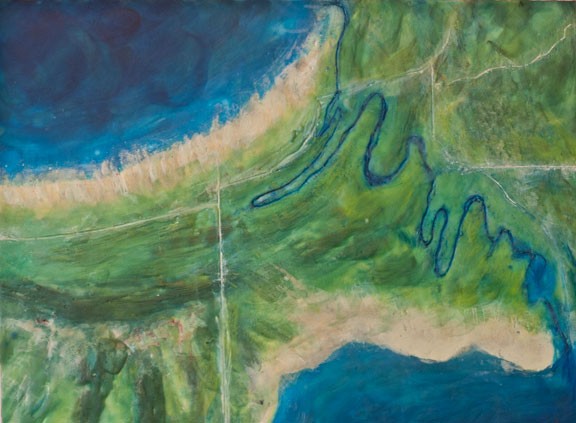
Artist statement:
"I have been fascinated with aerial views of landscape for many years. Chaperoning a high school service trip to New Orleans post-Hurricane Katrina made the power and the significance of the Mississippi River painfully, viscerally, real. These pieces were inspired by that trip and by my recent discovery of a series of beautiful survey maps of the Mississippi River done by Harold Fisk in the 1940s."
"Some of these pieces start by making a digital image starting from old maps, changing them, drawing into them and altering them in Photoshop and printing them with my large format archival printer on Rives BFK paper. Some are purely hand-worked; only physical – using encaustic, collage, oil pastels, charcoal, conte and other media. The motion and physicality of the work echoes my emotion about the power of the river’s ever-changing channels. The two-part process of my work integrates technology and nature, echoing my thematic exploration of our interconnected environment."
Artist biography:
Leslie Sobel received her BFA from the University of Michigan School of Art in 1983. She worked in computer graphics for many years and did master’s degree work in Interdisciplinary Technology at Eastern Michigan University.
Sobel's work focuses on the environment and the ways people change, understand and interact with it. Sobel uses a combination of scientific imaging, including satellite and photomicrographs, computer code and maps as well as mixed media with encaustic (wax based) paint and sculpture to create her work. A member of the Arts Alliance board and chair of the Milan Art Center, she co-founded the art alchemists, an artists”˜ collective revolving around the use of digital tools in art-making. She also was a partner in the Washington Street Gallery for a number of years.
She is an avid hiker whose connection with the outdoors is crucial to her work. Sobel is married and has three young adult children. She has lived in southeast Michigan for more than 30 years and grew up in Chicago.


